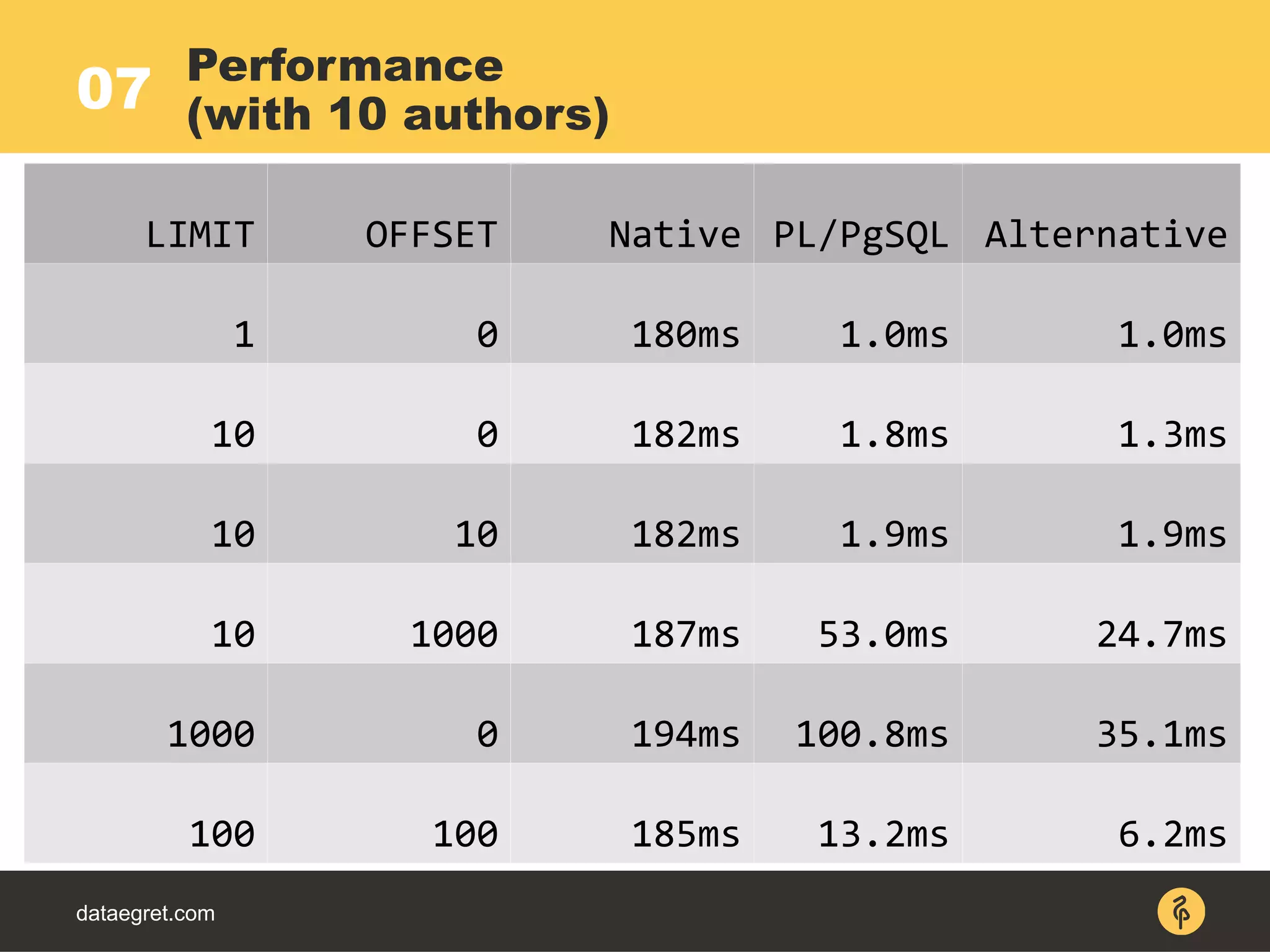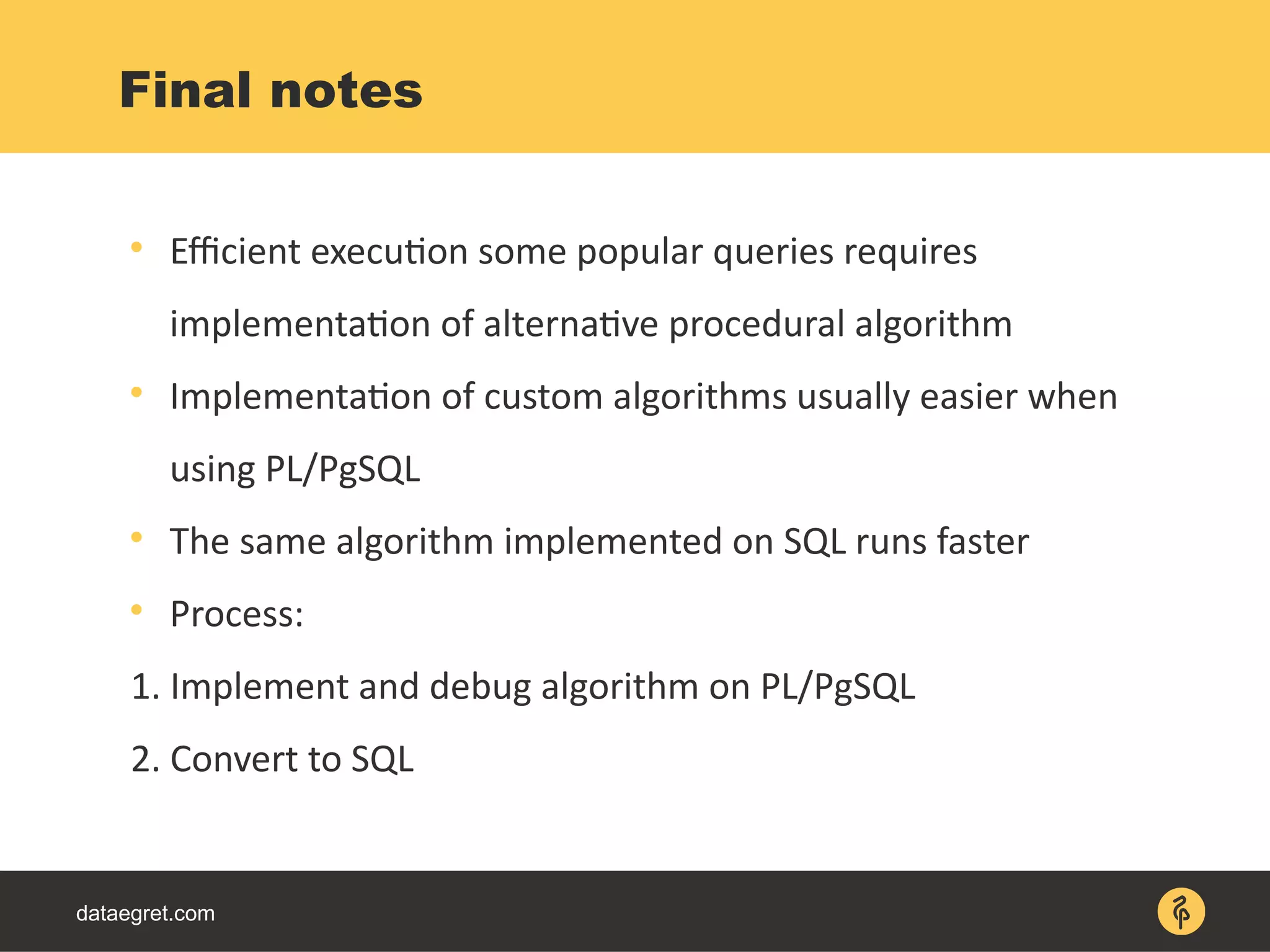The document discusses techniques for optimizing PostgreSQL queries, including:
1. Using index only scans to efficiently skip large offsets in queries instead of scanning all rows.
2. Pulling the LIMIT clause under joins and aggregates to avoid processing unnecessary rows.
3. Employing indexes creatively to perform DISTINCT operations by scanning the index instead of the entire table.
4. Optimizing DISTINCT ON queries by looping through authors and returning the latest row for each instead of a full sort.
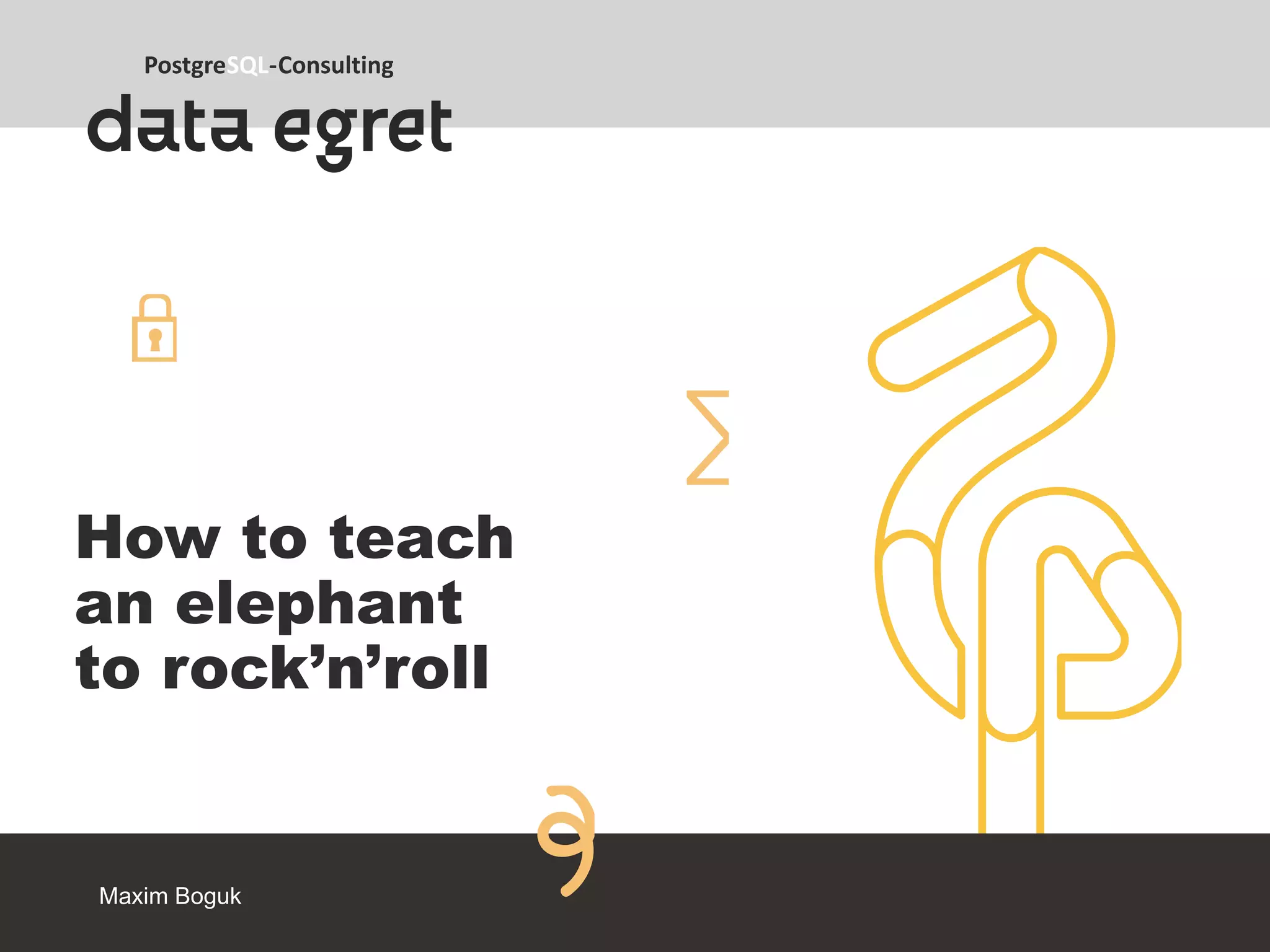

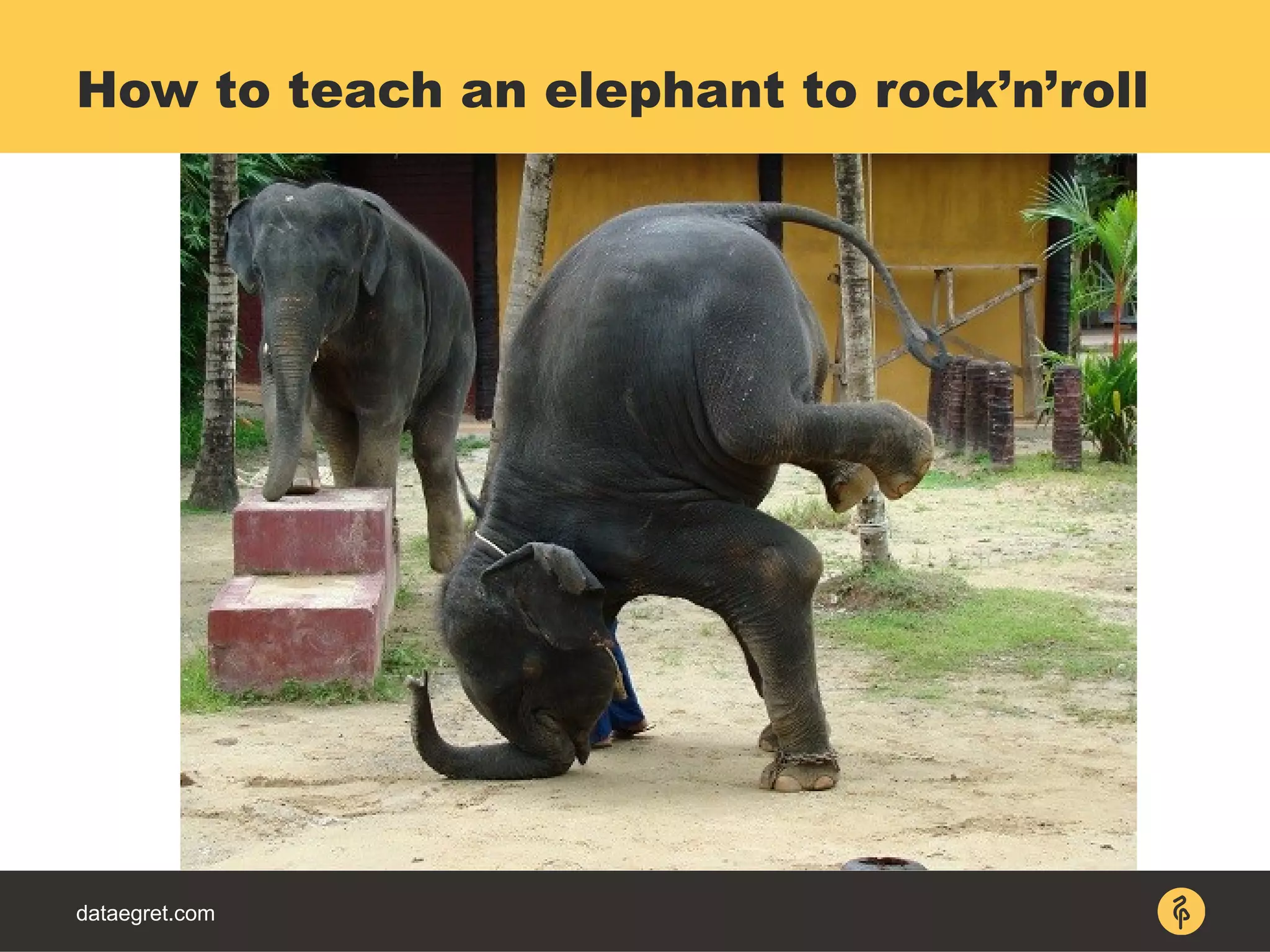
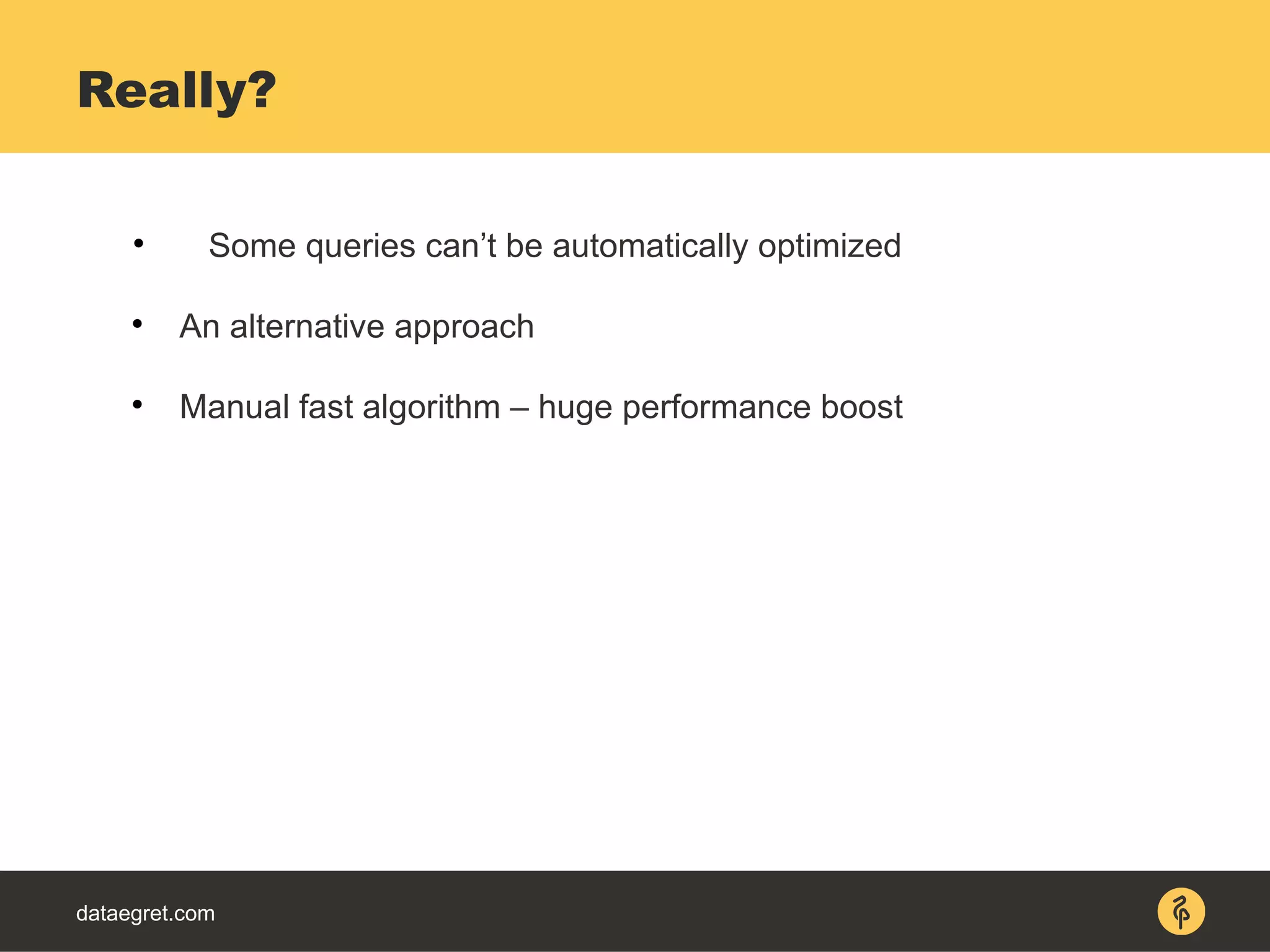
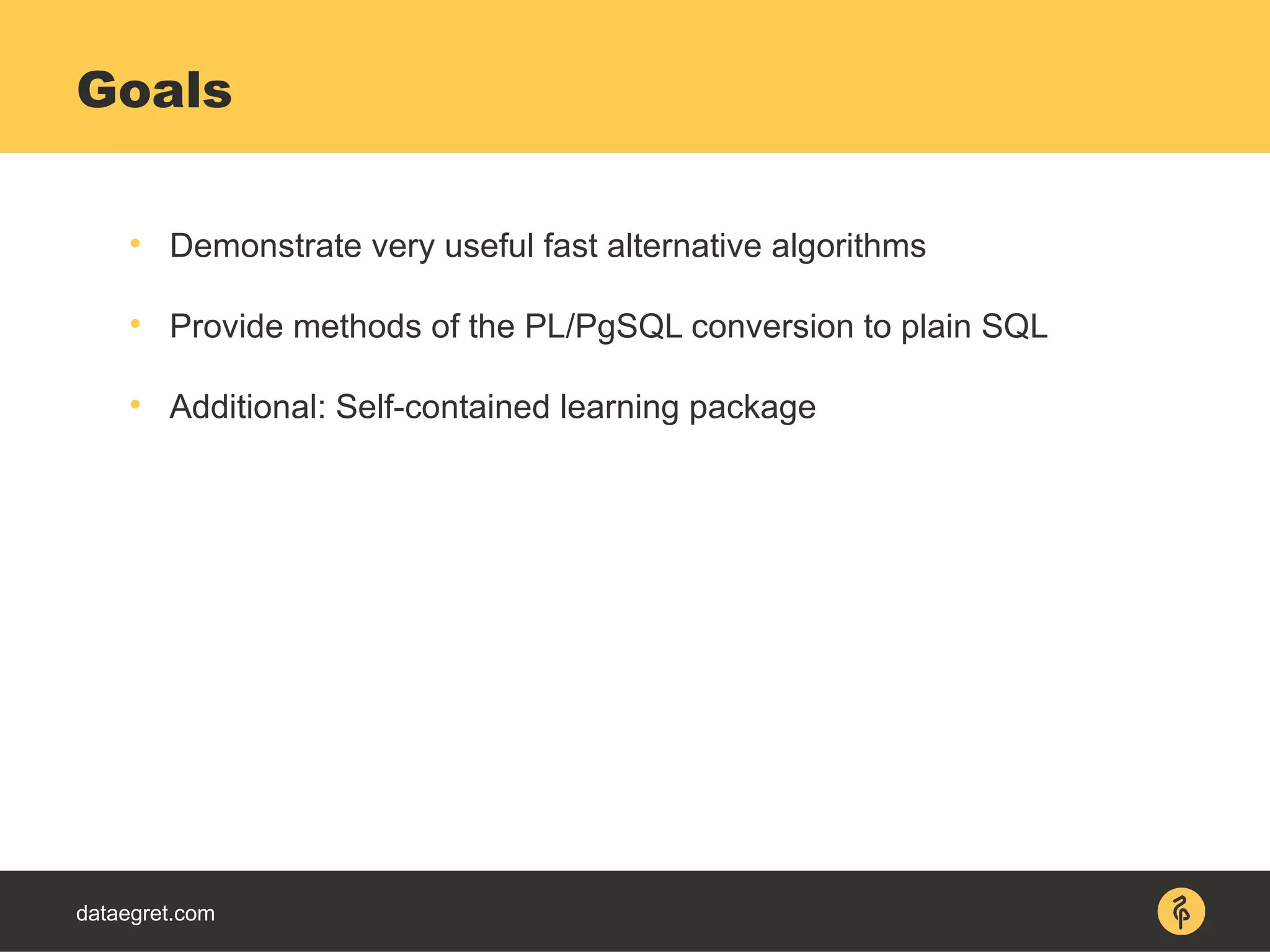
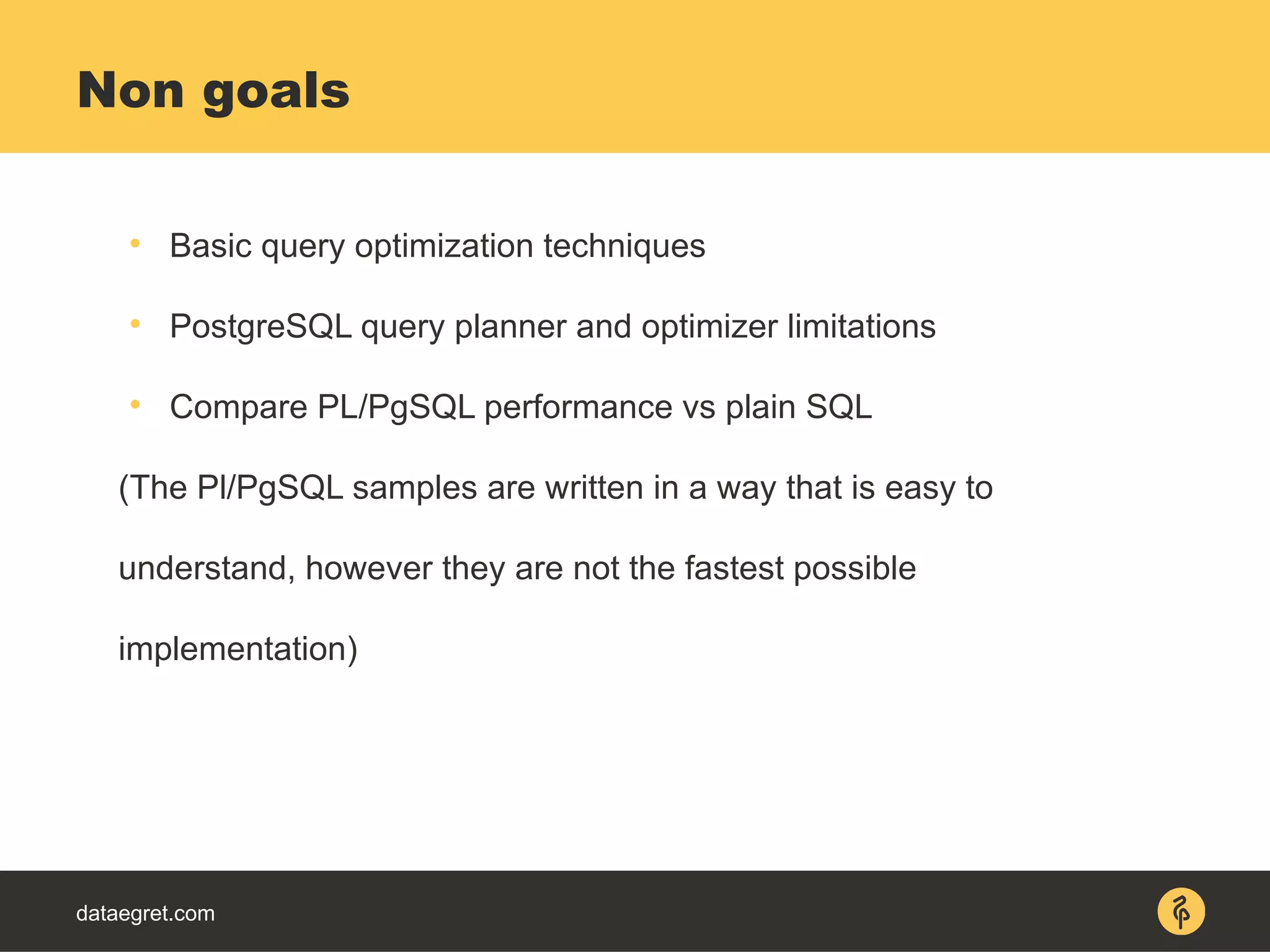
![dataegret.com
PL/PgSQL knowledge
PostgreSQL SQL features:
WITH [RECURSIVE]
[JOIN] LATERAL
UNNEST [WITH ORDINALITY]
Prerequisites](https://image.slidesharecdn.com/maximpgdayasia2017-170319053541/75/How-to-teach-an-elephant-to-rock-n-roll-7-2048.jpg)
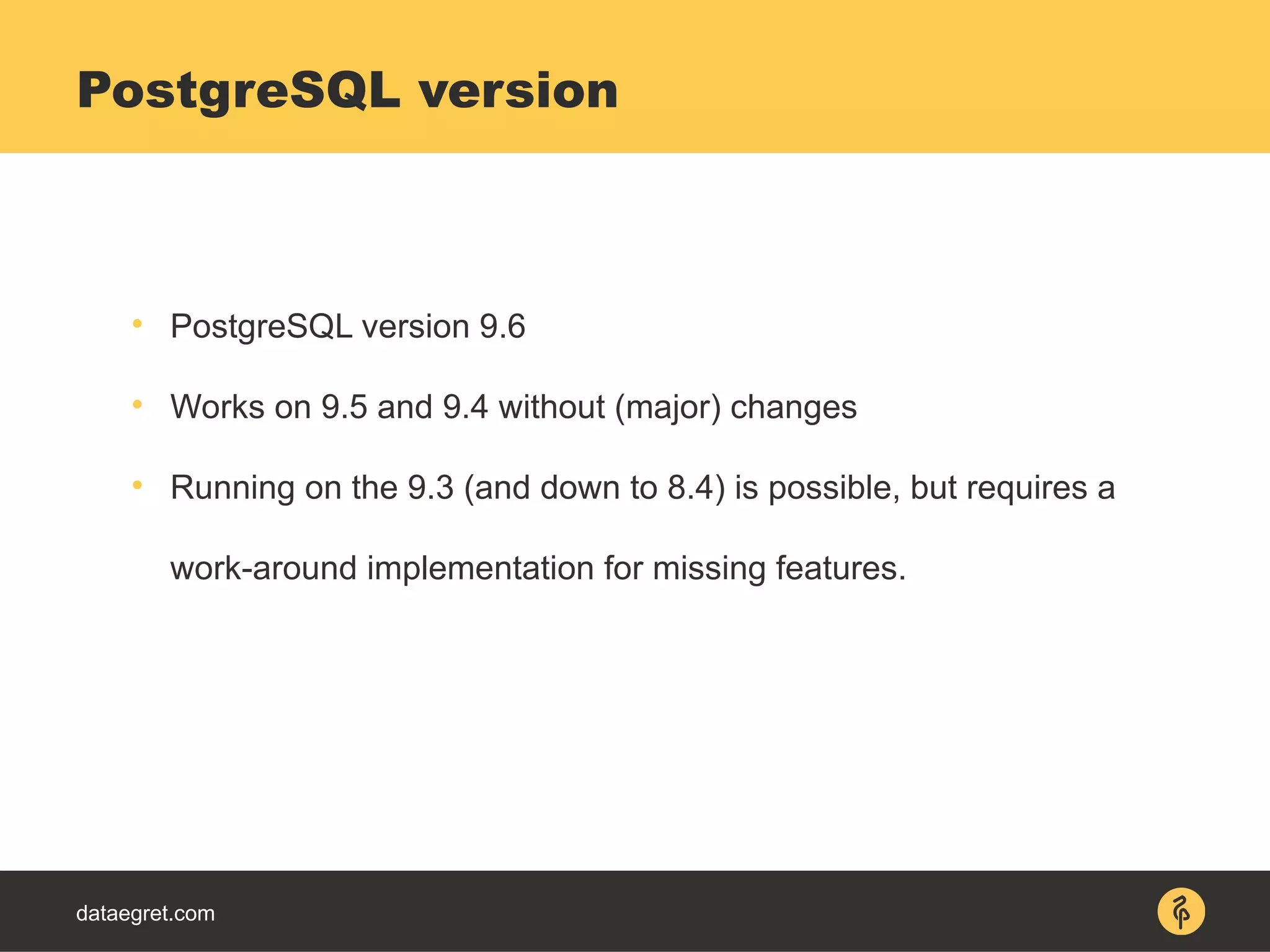

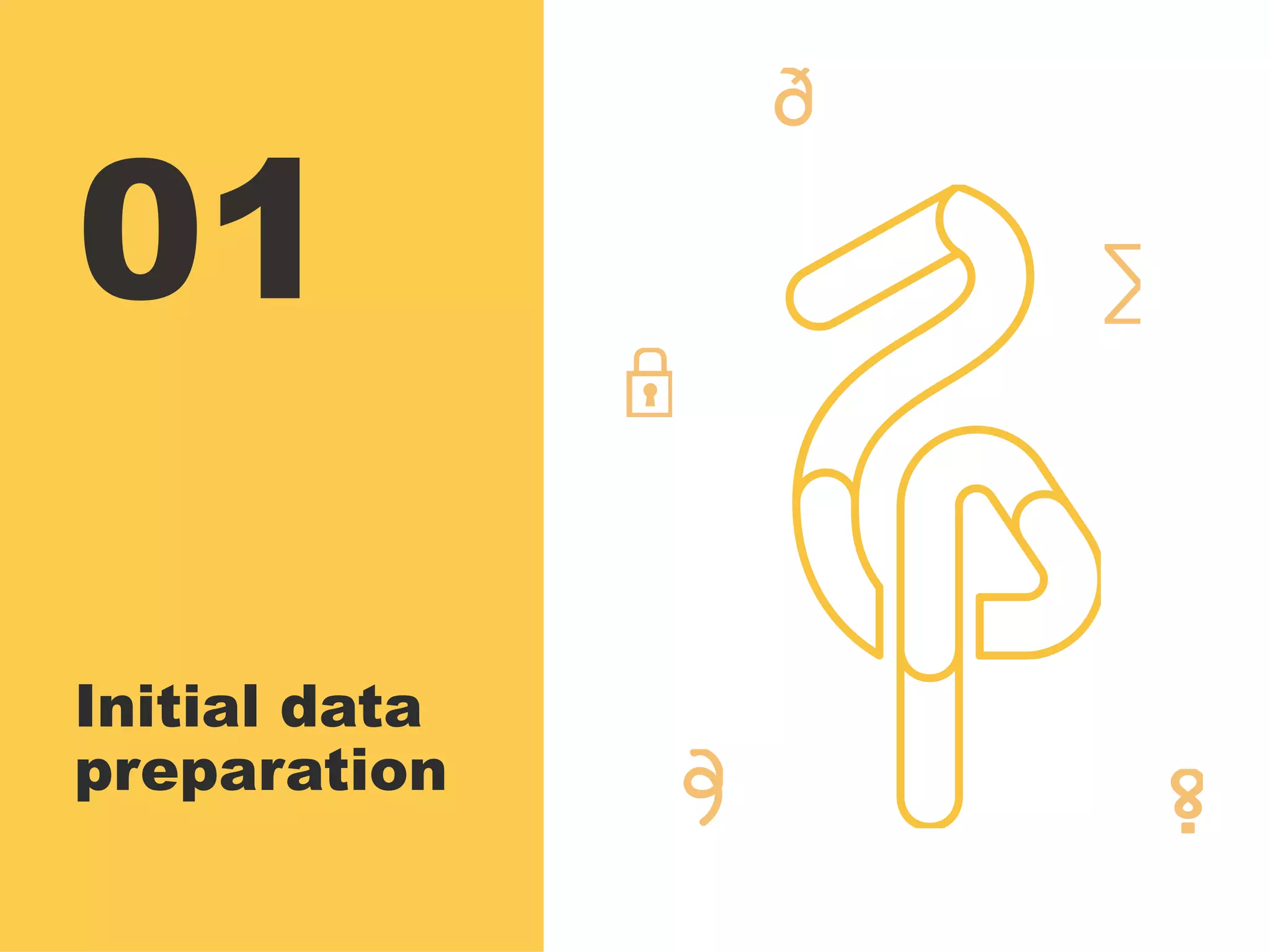


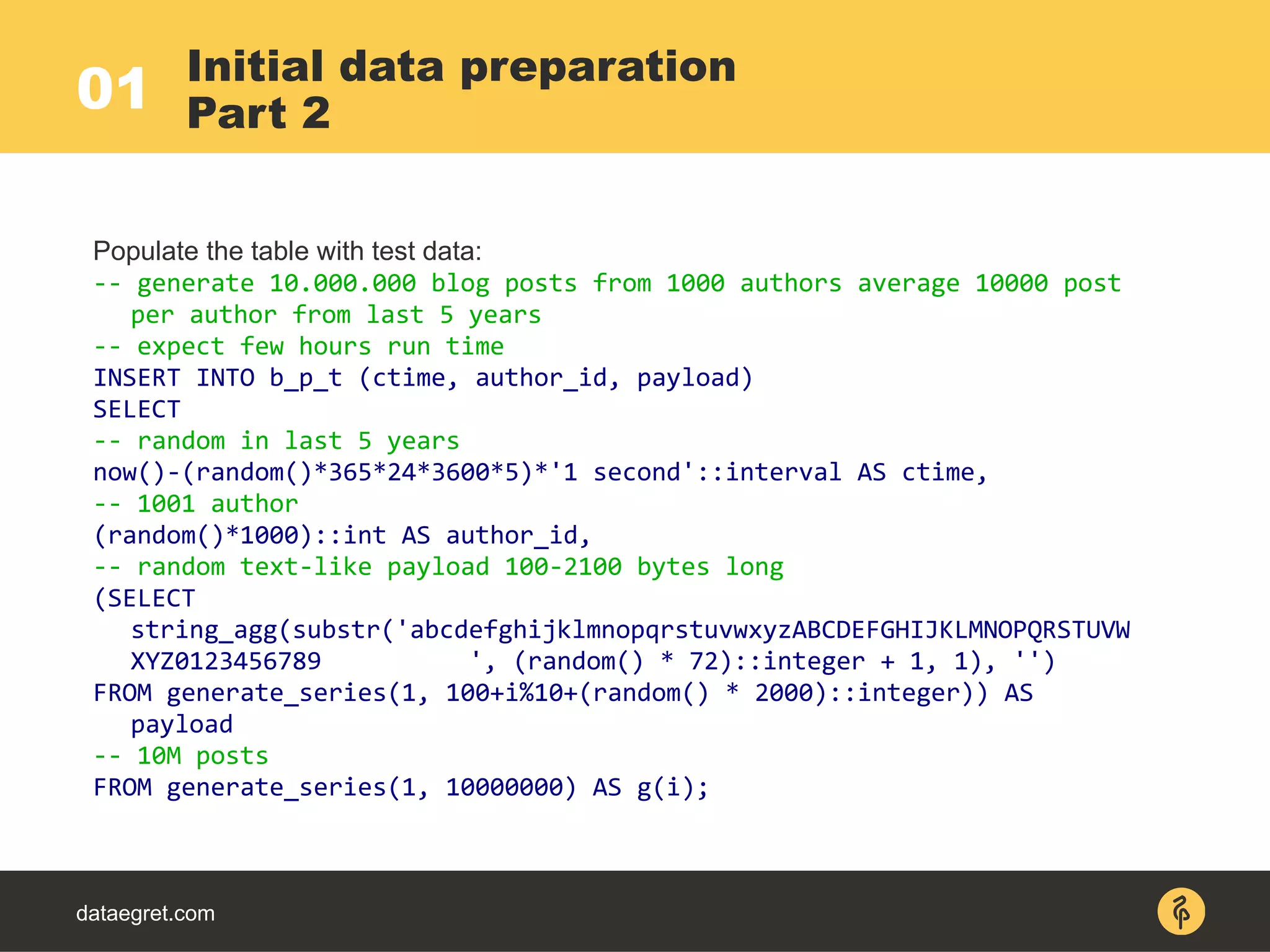

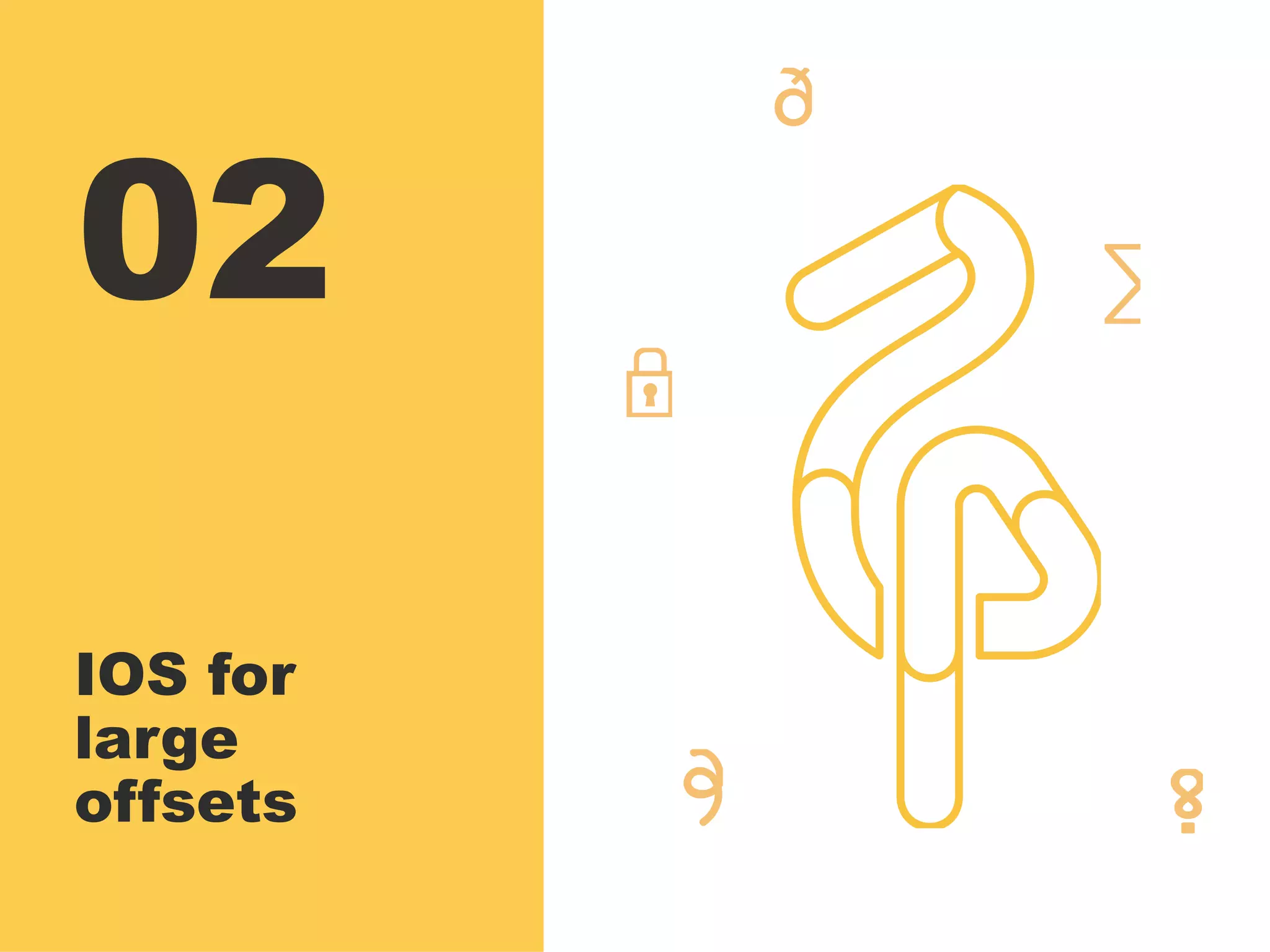
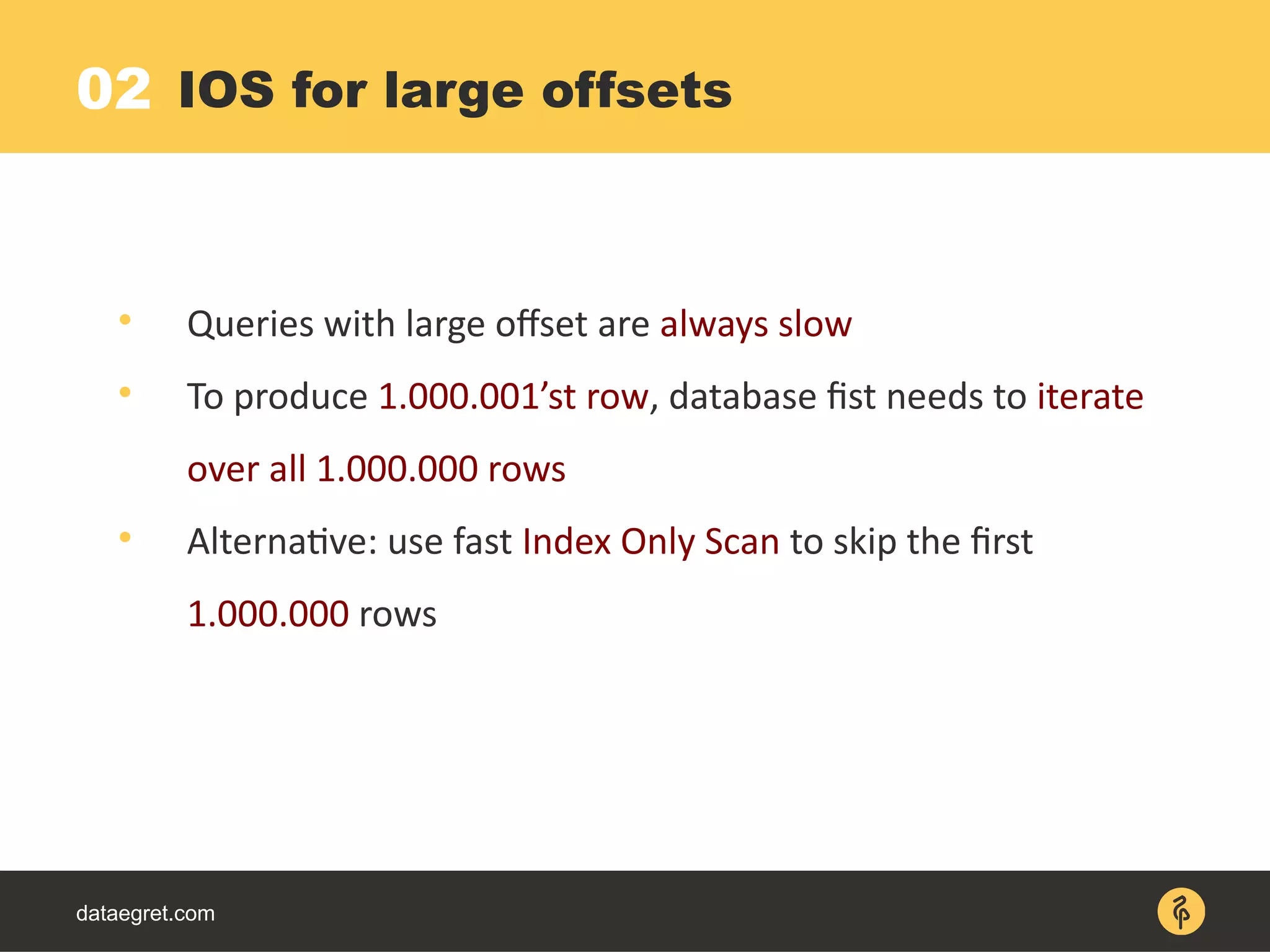
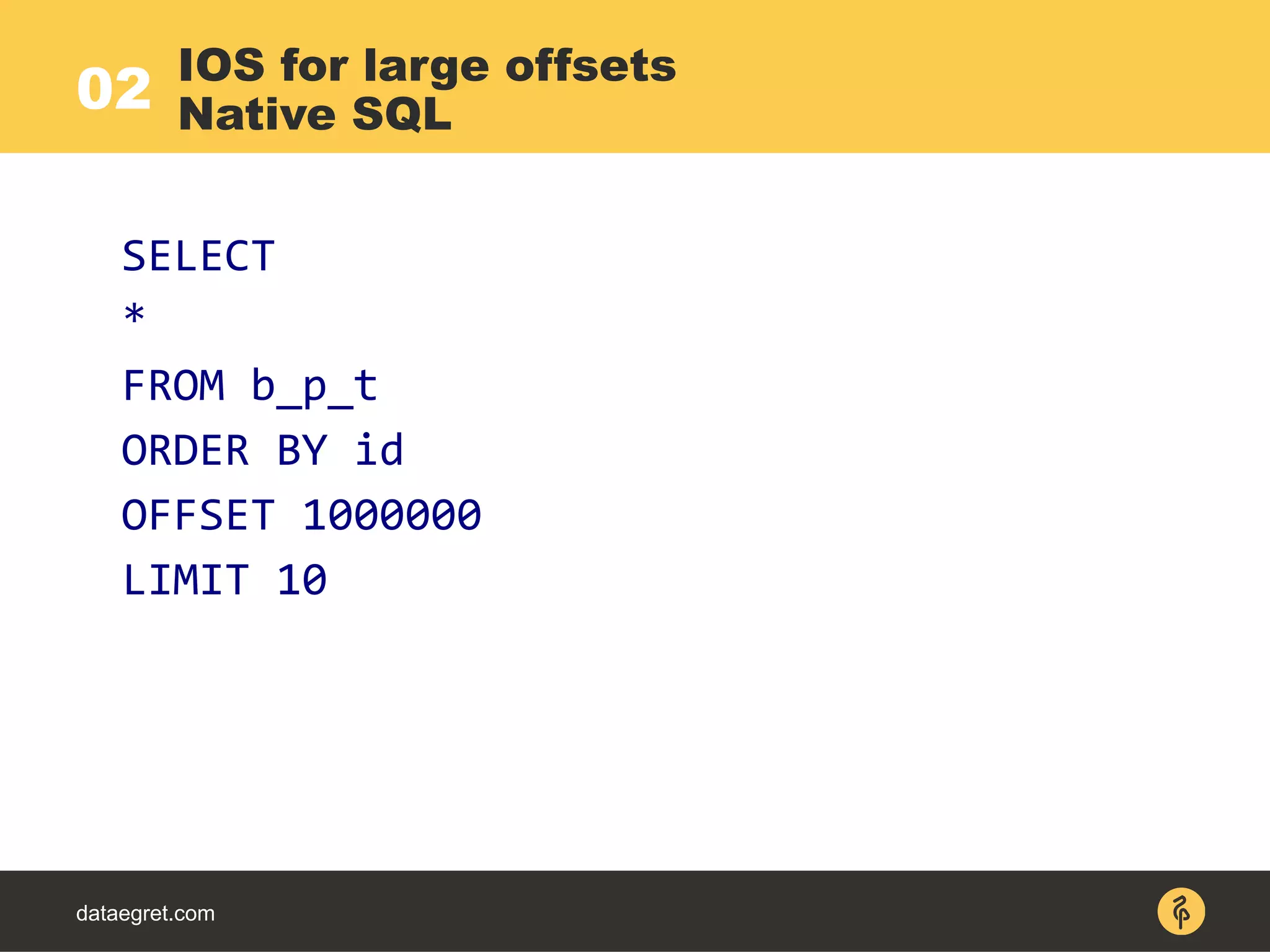
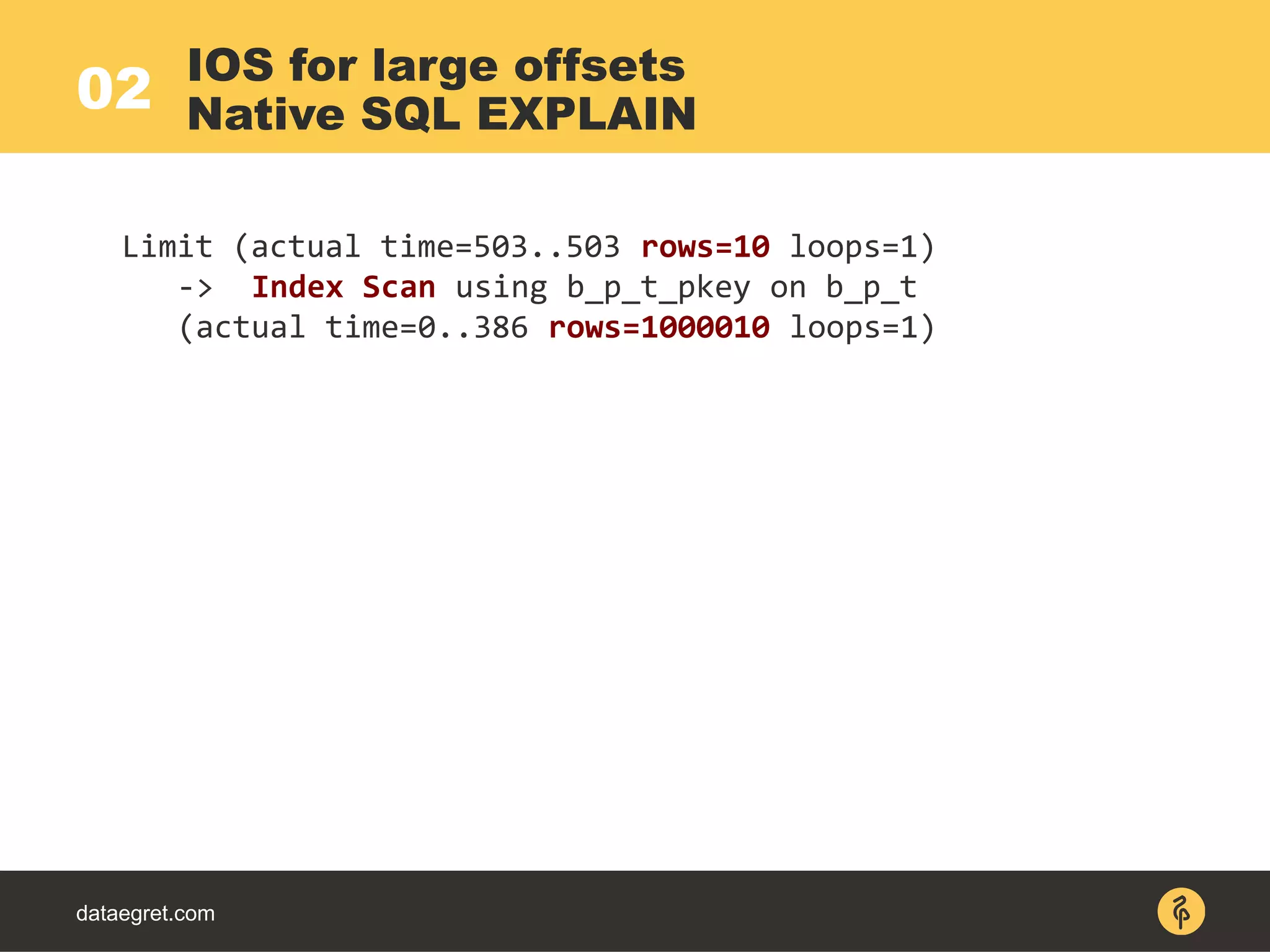
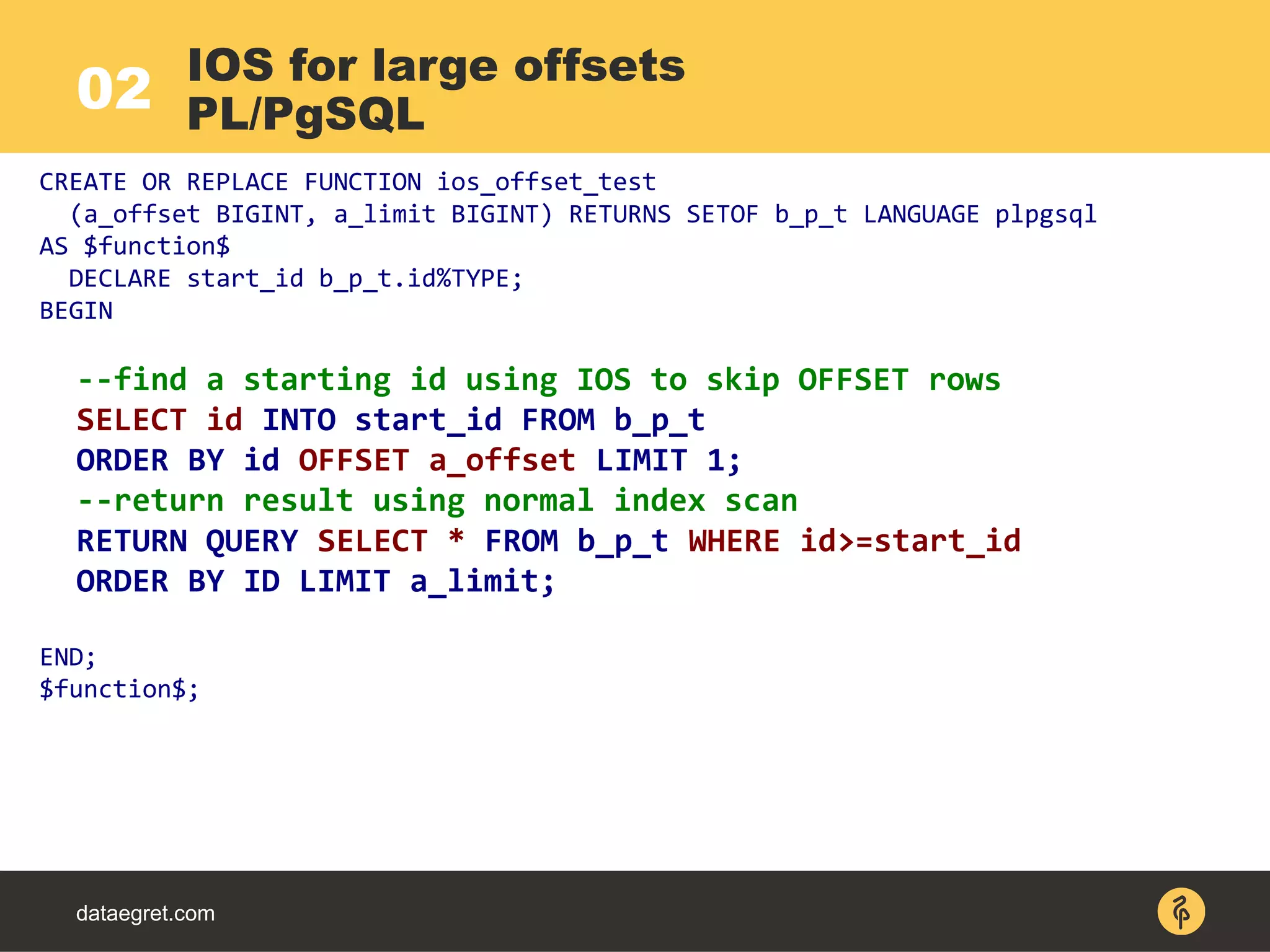
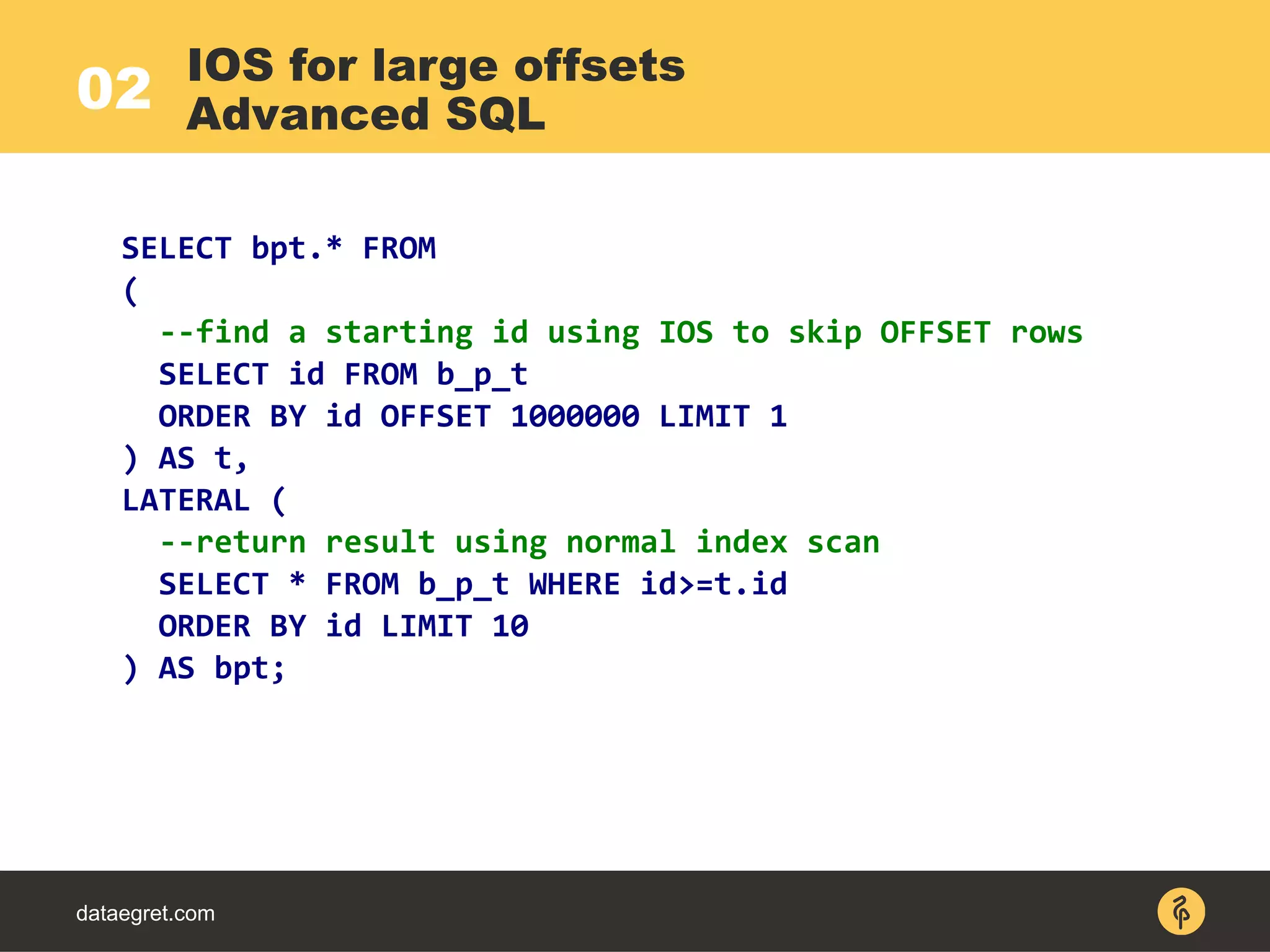
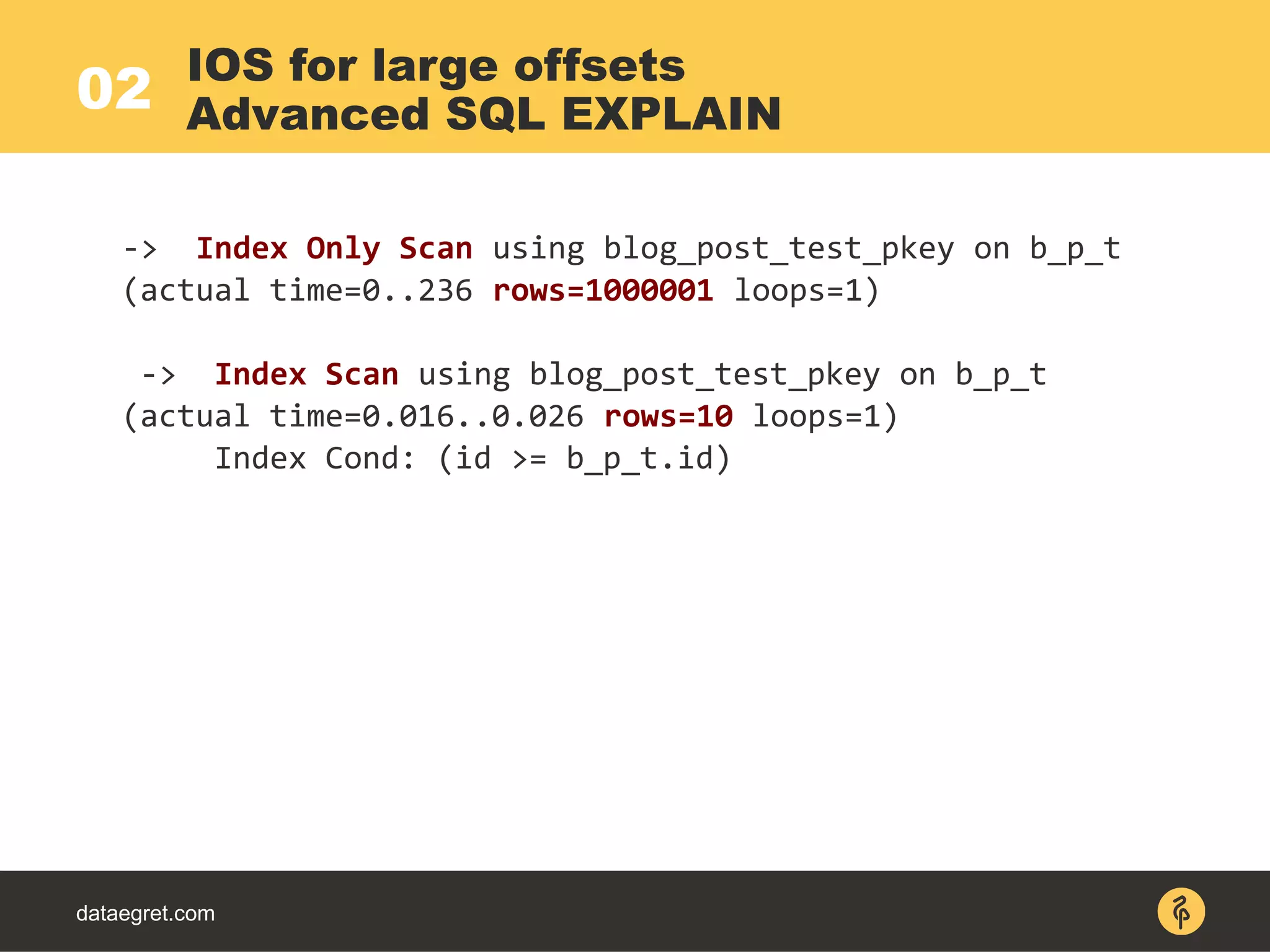
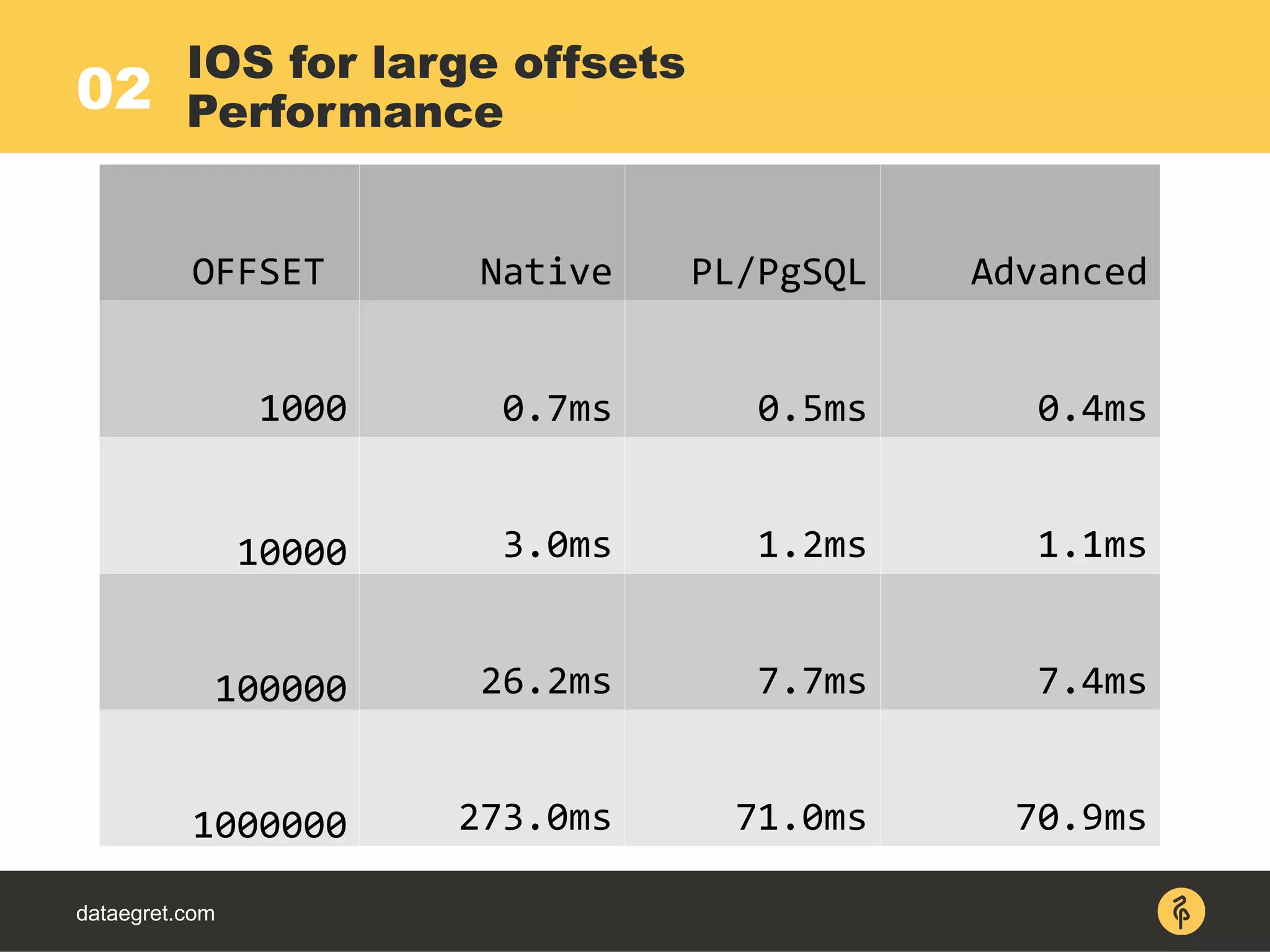

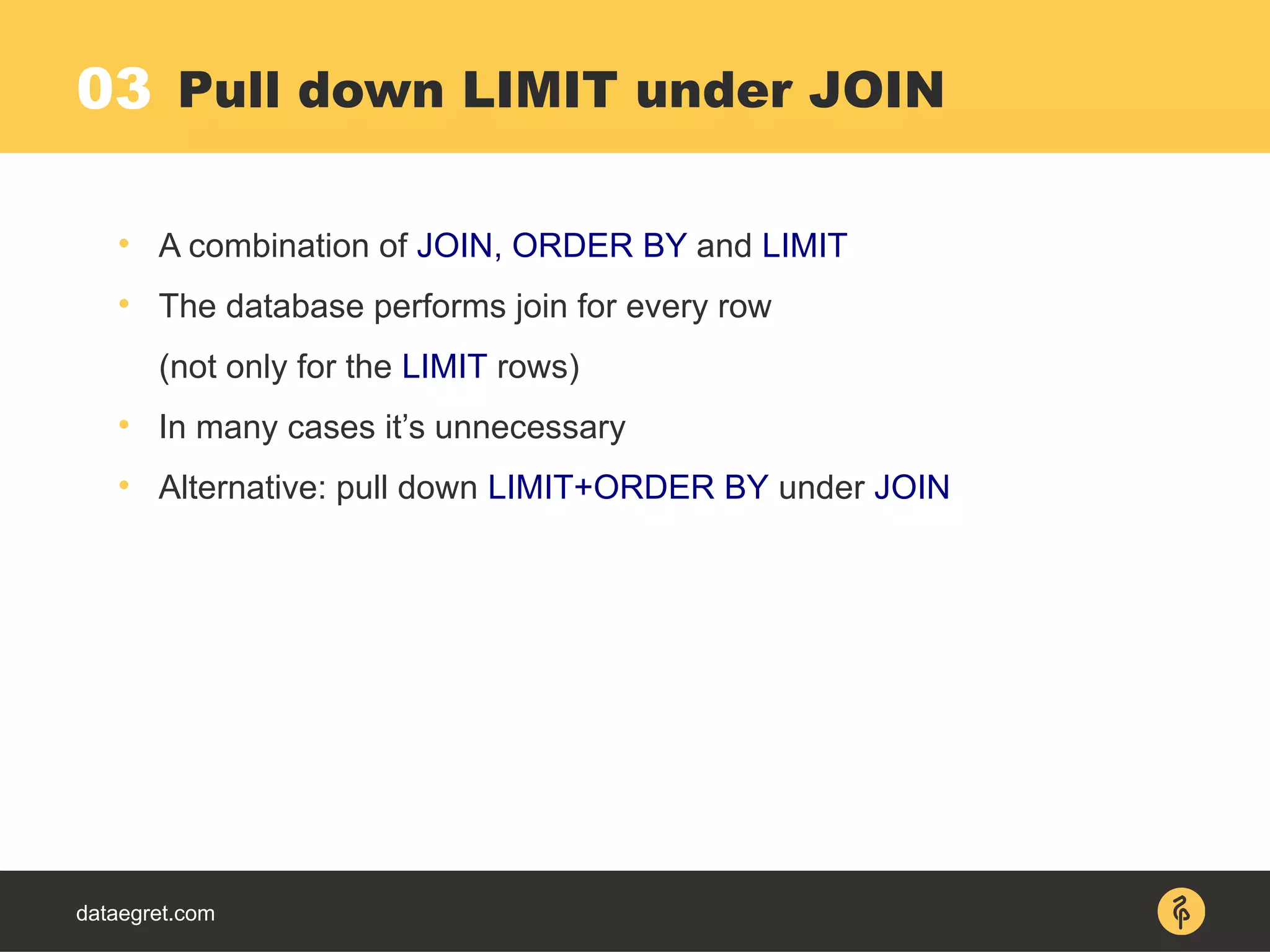
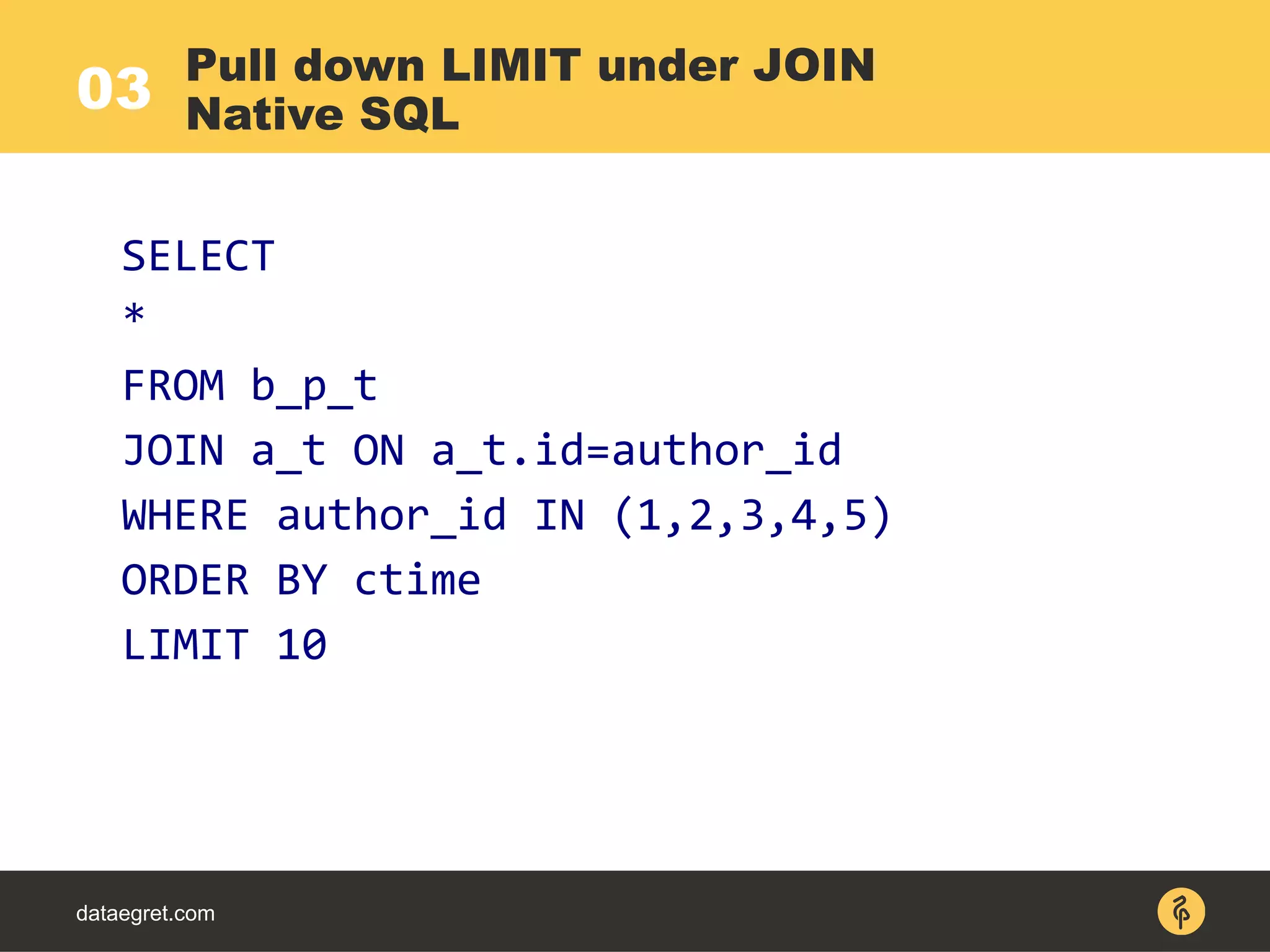
![03
dataegret.com
-> Sort (actual time=345..345 rows=10 loops=1)
-> Nested Loop (actual time=0.061..295.832 rows=50194
loops=1)
-> Index Scan using b_p_t_author_id_ctime_ukey on
b_p_t (actual time=0..78 rows=50194 loops=1)
Index Cond: (author_id = ANY
('{1,2,3,4,5}'::integer[]))
-> Index Scan using a_t_pkey on a_t
(actual time=0.002 rows=1 loops=50194)
Index Cond: (id = b_p_t.author_id)
Pull down LIMIT under JOIN
Native SQL EXPLAIN](https://image.slidesharecdn.com/maximpgdayasia2017-170319053541/75/How-to-teach-an-elephant-to-rock-n-roll-26-2048.jpg)
![03
dataegret.com
CREATE OR REPLACE FUNCTION join_limit_pulldown_test (a_authors BIGINT[],
a_limit BIGINT)
RETURNS TABLE (id BIGINT, ctime TIMESTAMP, author_id INT, payload TEXT, name
TEXT) LANGUAGE plpgsql
AS $function$
DECLARE t record;
BEGIN
FOR t IN (
-- find ONLY required rows first
SELECT * FROM b_p_t
WHERE b_p_t.author_id=ANY(a_authors)
ORDER BY ctime LIMIT a_limit
) LOOP
-- and only after join with authors
RETURN QUERY SELECT t.*, a_t.name FROM a_t
WHERE a_t.id=t.author_id;
END LOOP;
END;
$function$;
Pull down LIMIT under JOIN
PL/PgSQL](https://image.slidesharecdn.com/maximpgdayasia2017-170319053541/75/How-to-teach-an-elephant-to-rock-n-roll-27-2048.jpg)

![03
dataegret.com
-> Nested Loop (actual time=68..68 rows=10 loops=1)
-> Sort (actual time=68..68 rows=10 loops=1)
-> Index Scan using b_p_t_author_id_ctime_ukey on b_p_t
(actual time=0..49 rows=50194 loops=1)
Index Cond: (author_id = ANY ('{1,2,3,4,5}'::integer[]))
-> Index Scan using a_t_pkey on a_t (actual
time=0.002..0.002 rows=1 loops=10)
Index Cond: (id = b_p_t.author_id)
Pull down LIMIT under JOIN
Advanced SQL EXPLAIN](https://image.slidesharecdn.com/maximpgdayasia2017-170319053541/75/How-to-teach-an-elephant-to-rock-n-roll-29-2048.jpg)
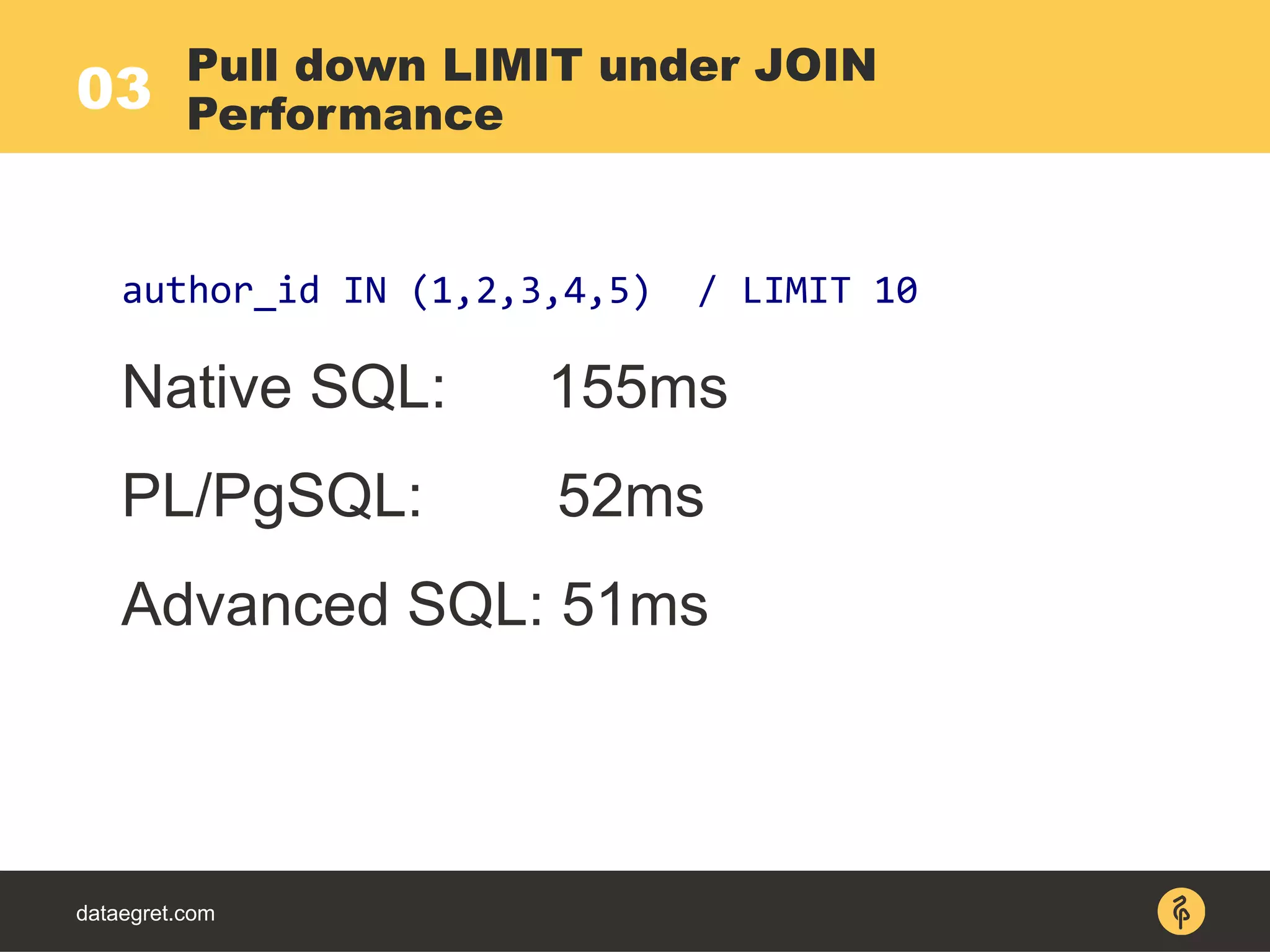
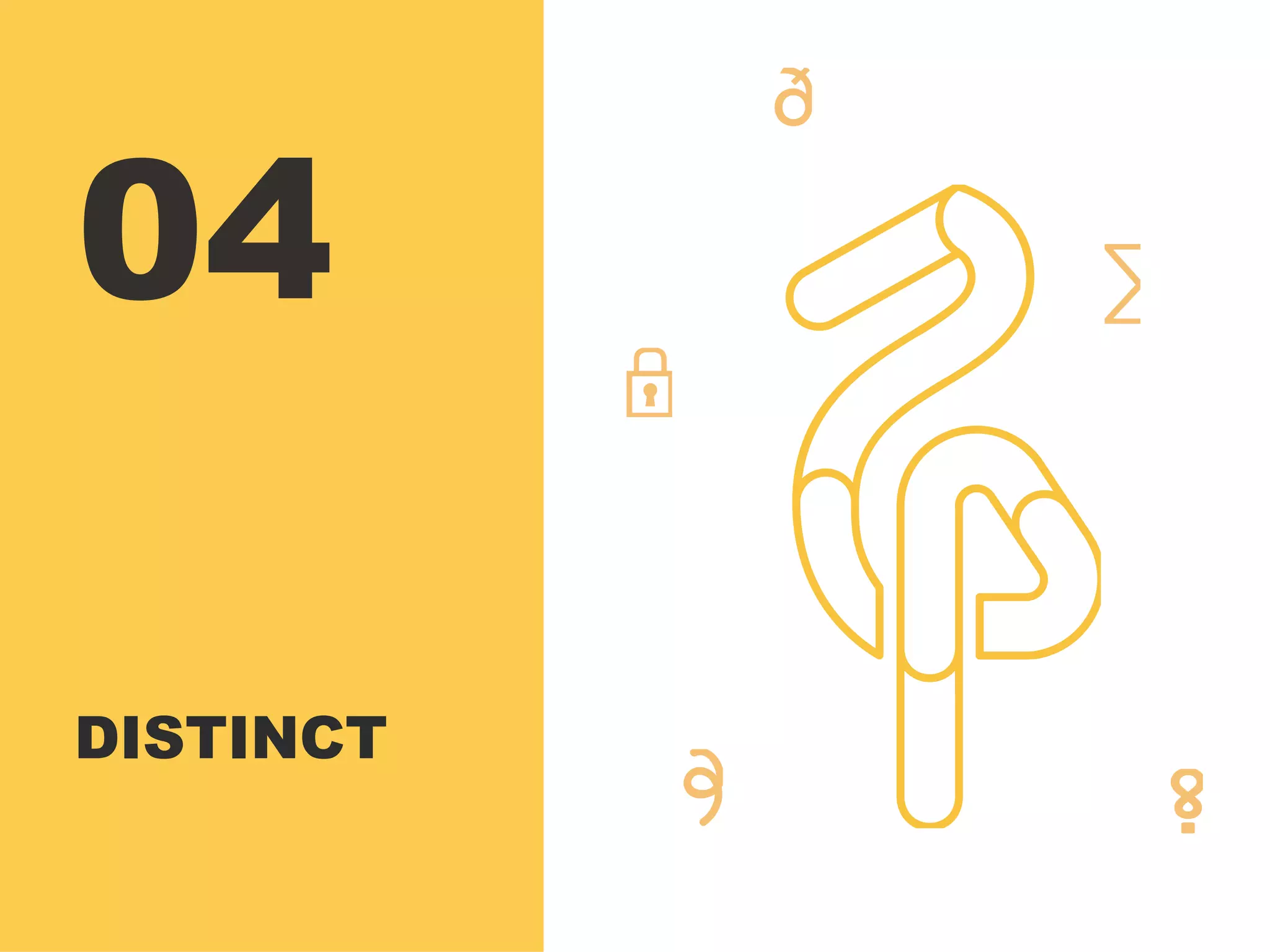
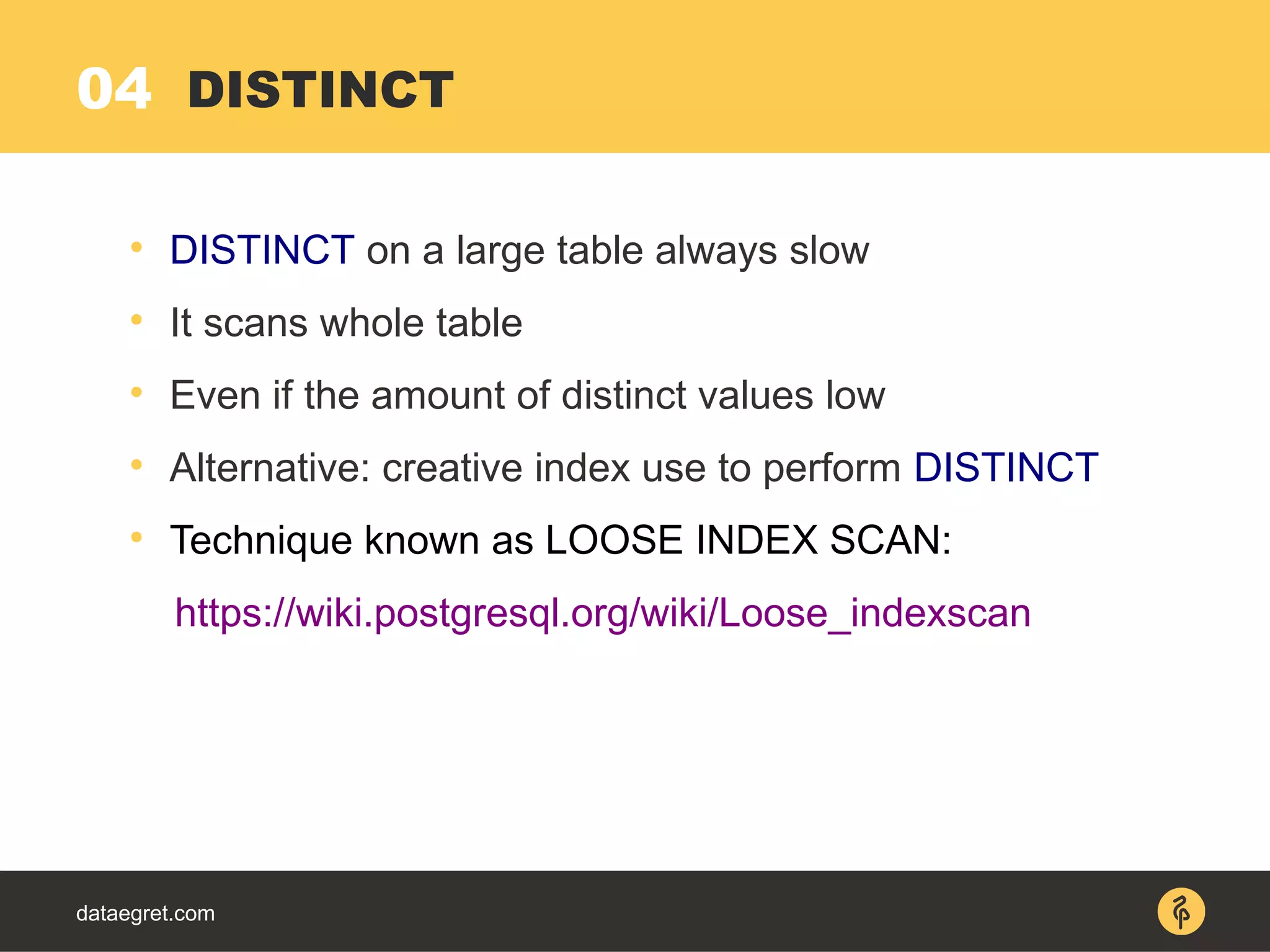
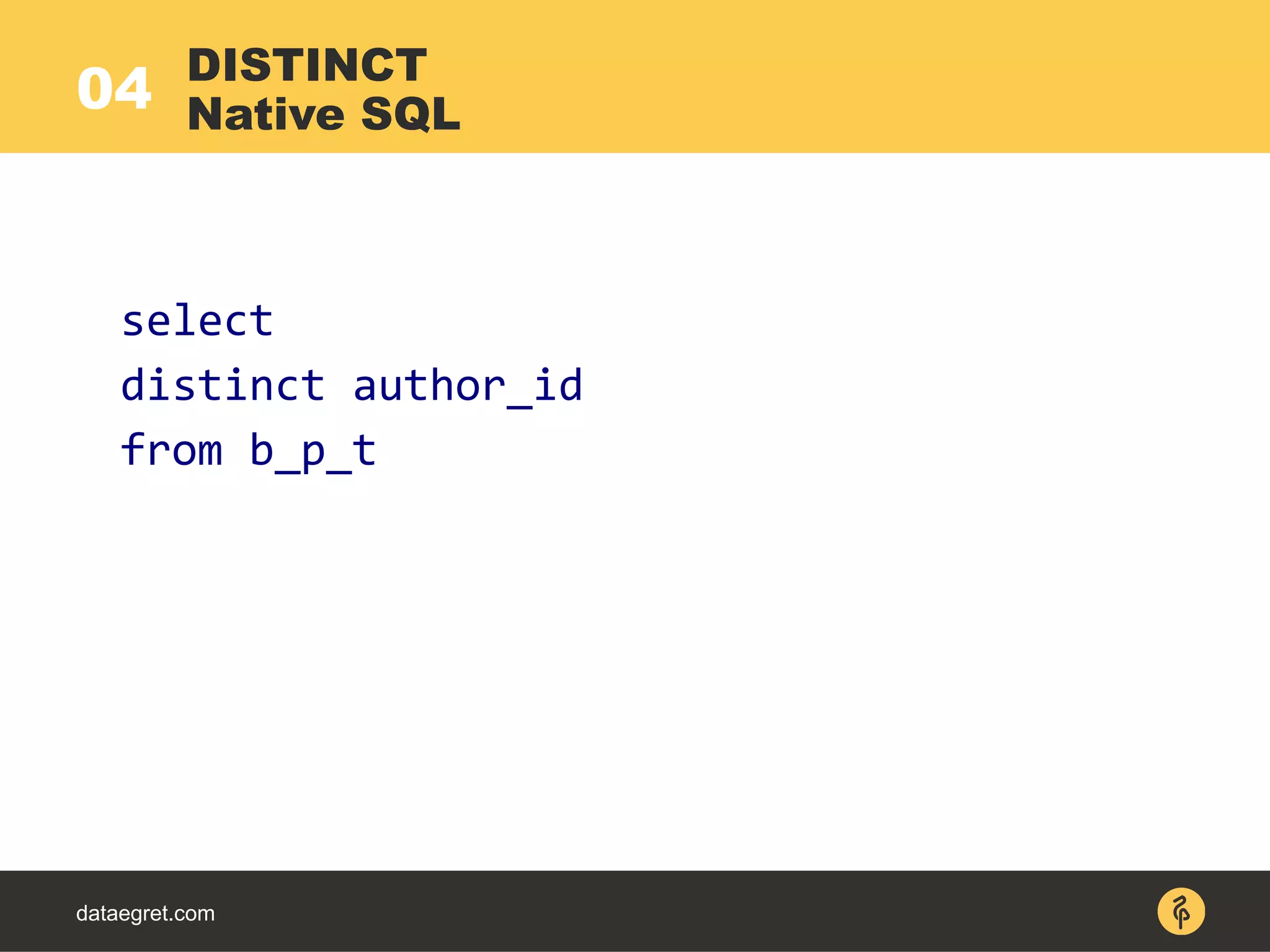
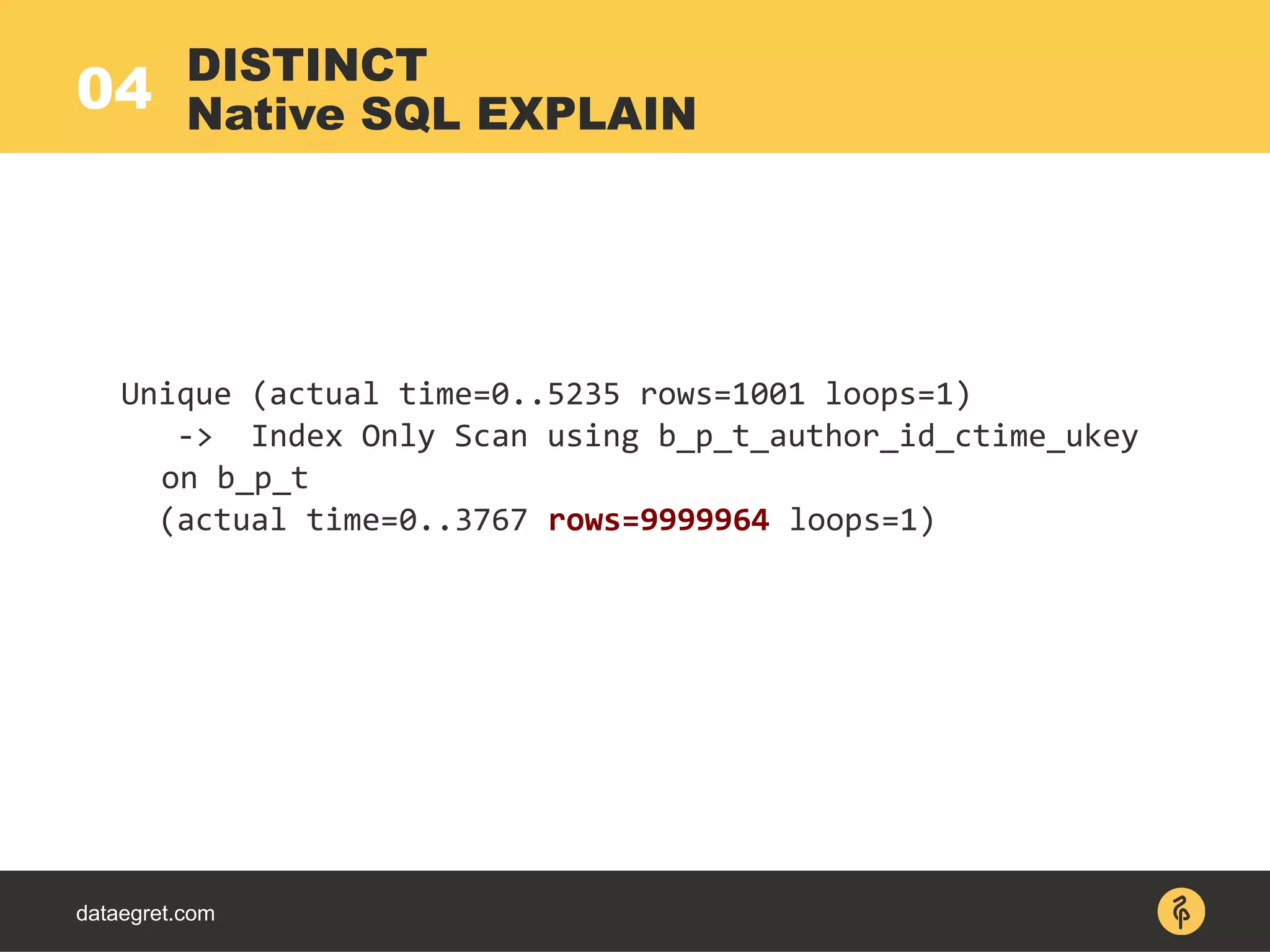
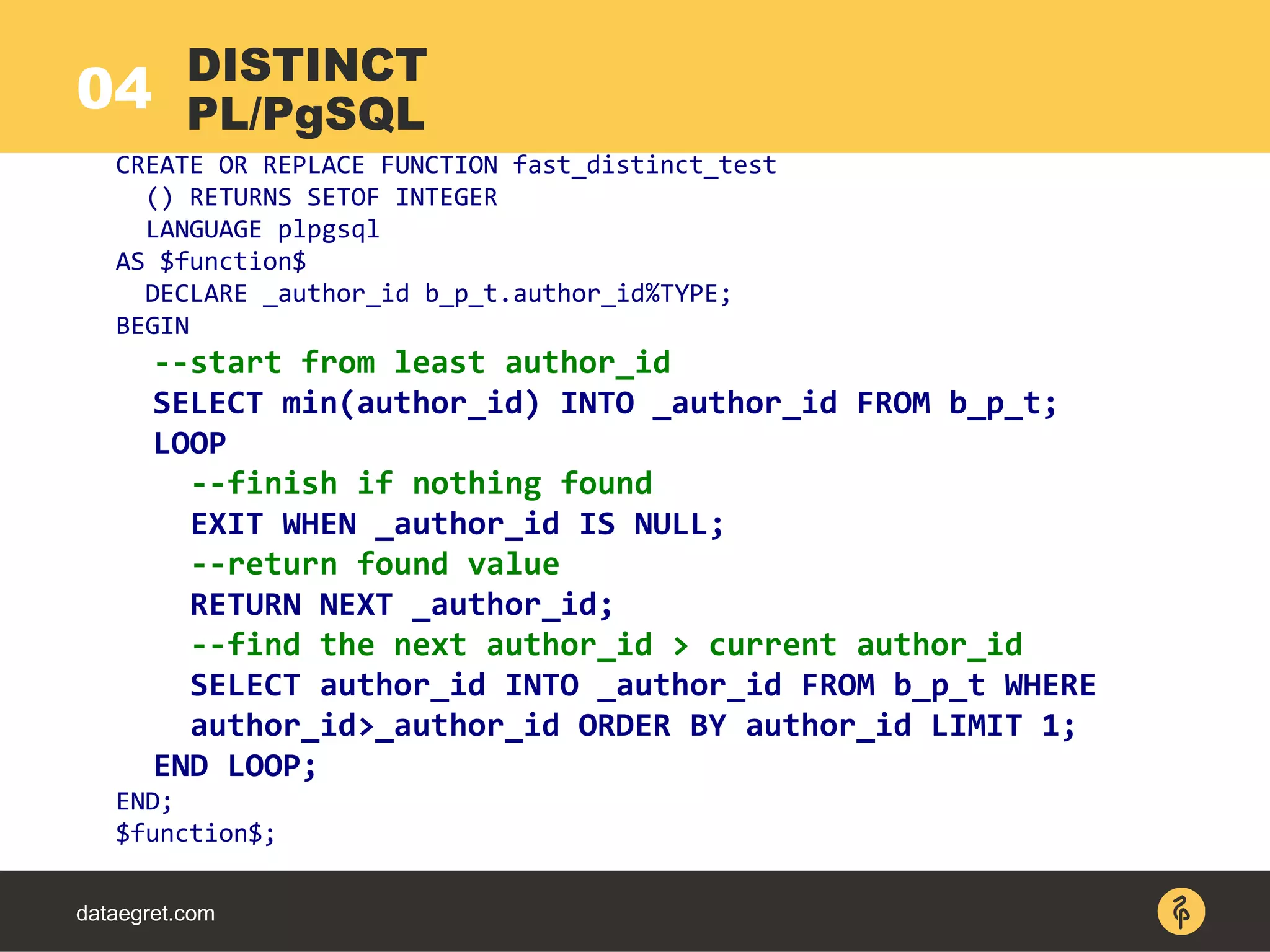
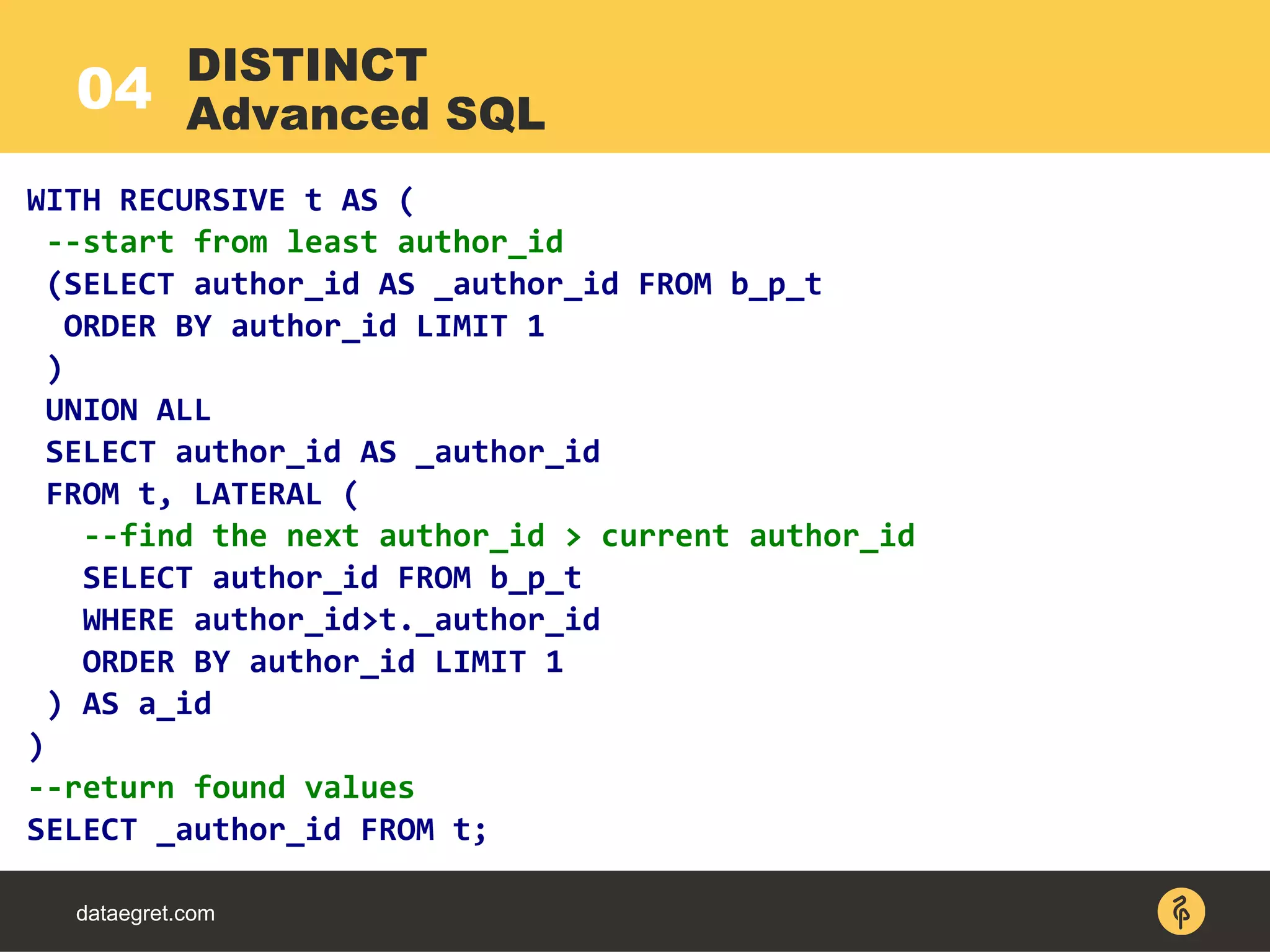
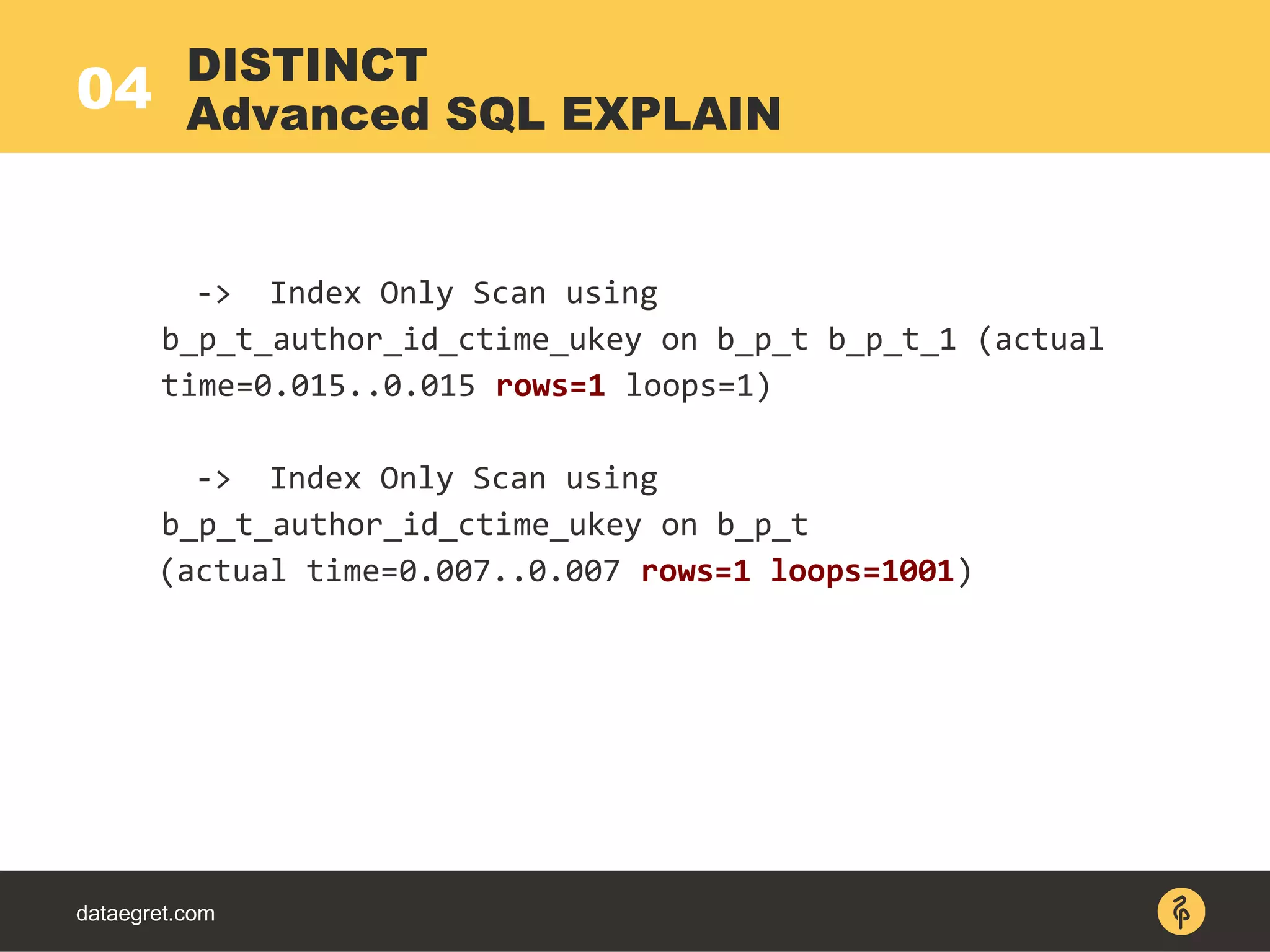

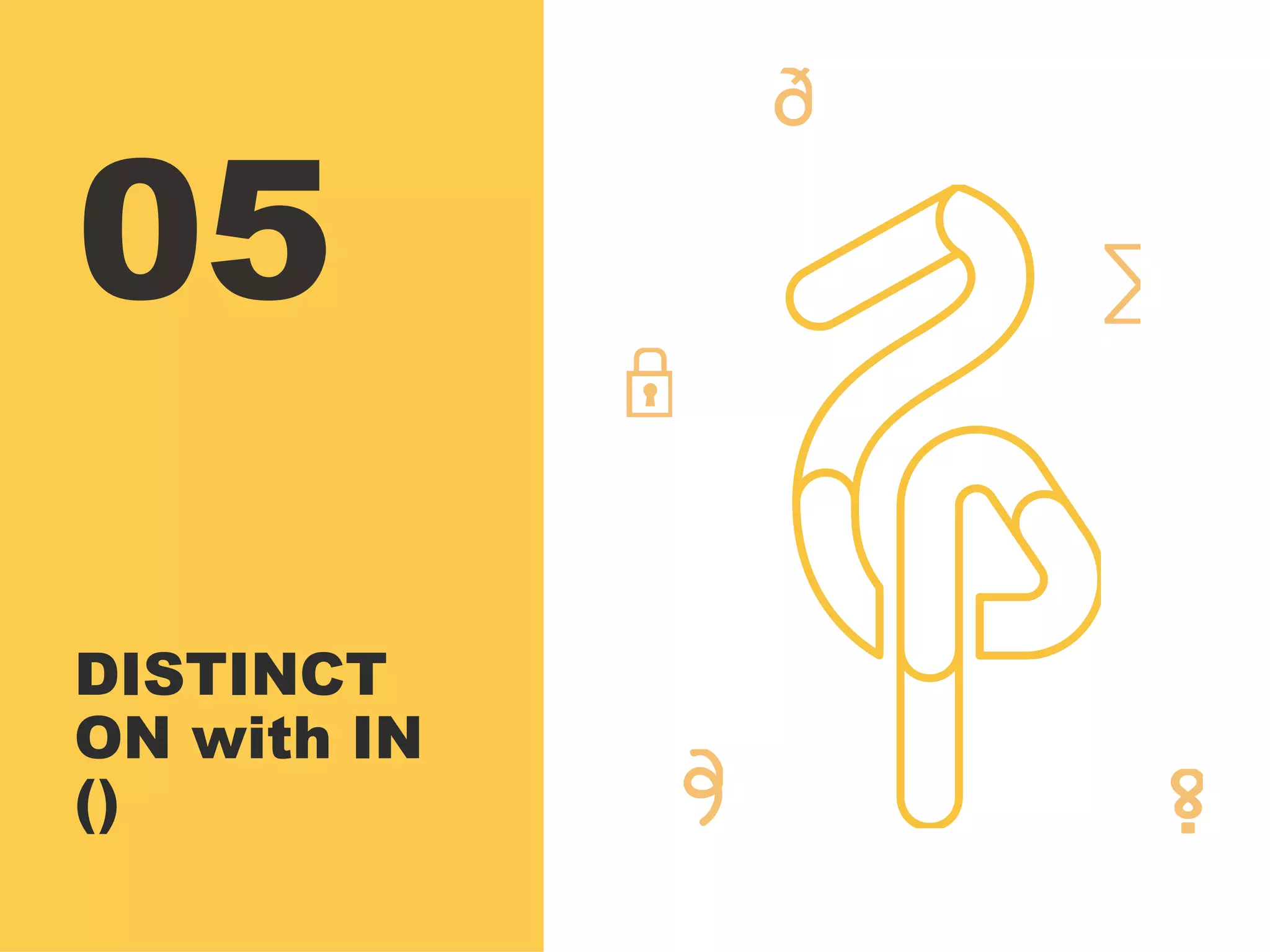
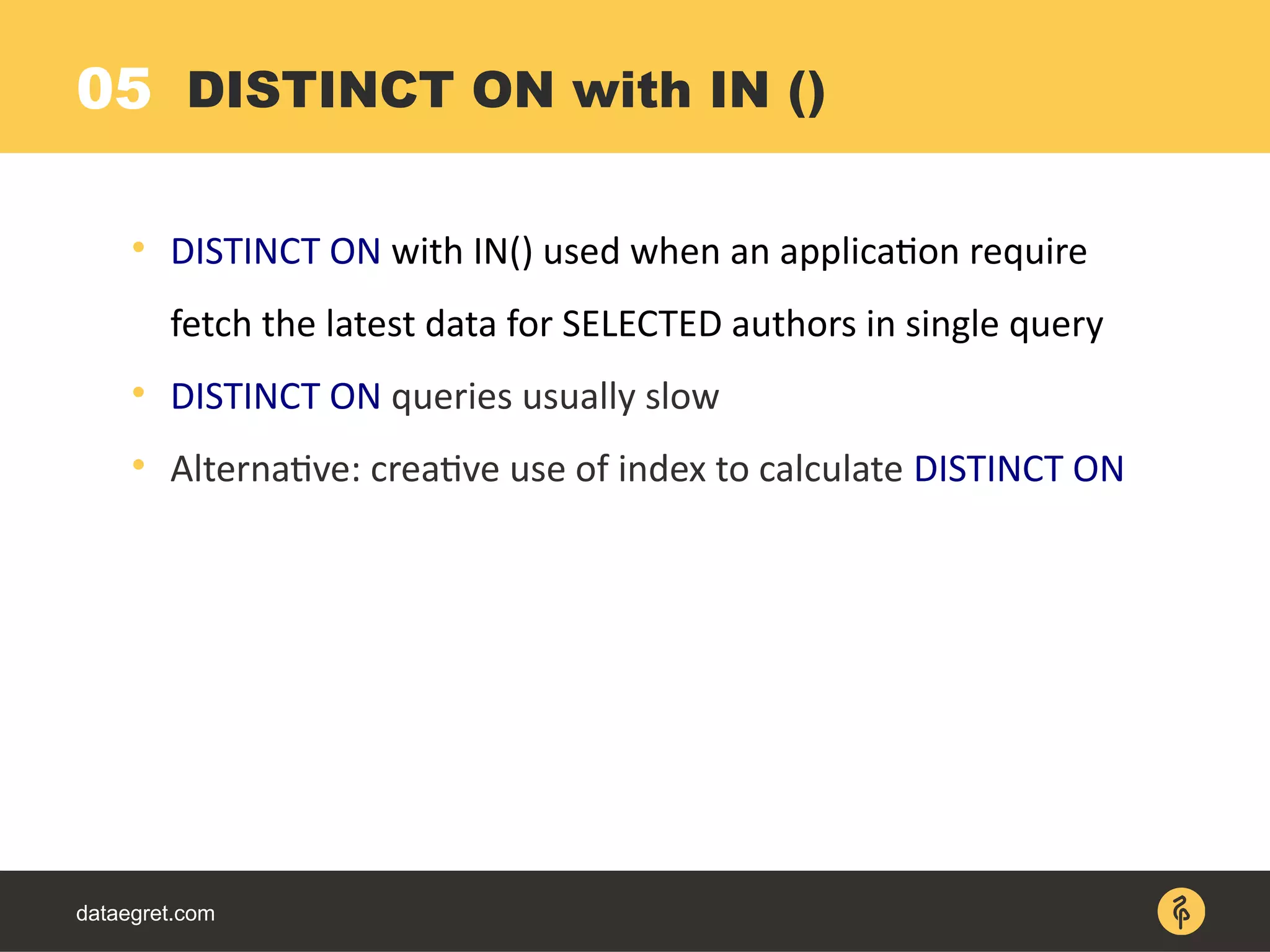
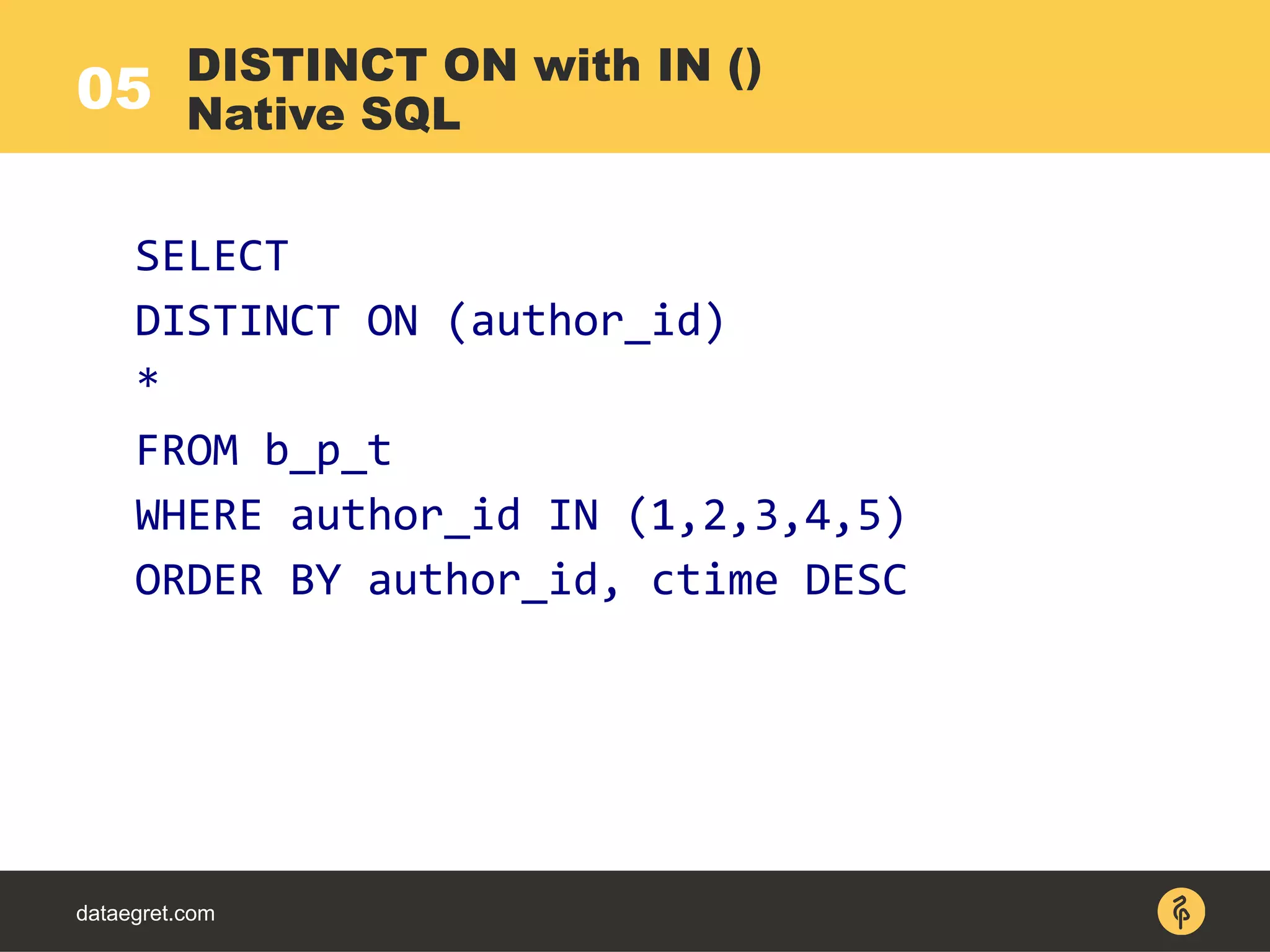
![05
dataegret.com
Unique (actual time=160..204 rows=5 loops=1)
-> Sort (actual time=160..195 rows=50194
loops=1)
-> Index Scan using
b_p_t_author_id_ctime_ukey on b_p_t (actual
time=0..50 rows=50194 loops=1)
Index Cond: (author_id = ANY
('{1,2,3,4,5}'::integer[]))
DISTINCT ON with IN ()
Native SQL EXPLAIN](https://image.slidesharecdn.com/maximpgdayasia2017-170319053541/75/How-to-teach-an-elephant-to-rock-n-roll-42-2048.jpg)
![05
dataegret.com
CREATE OR REPLACE FUNCTION distinct_on_test
(a_authors INT[]) RETURNS SETOF b_p_t
LANGUAGE plpgsql
AS $function$
DECLARE _a b_p_t.author_id%TYPE;
BEGIN
-- loop over authors list
FOREACH _a IN ARRAY a_authors LOOP
-- return the latest post for author
RETURN QUERY SELECT * FROM b_p_t
WHERE author_id=_a ORDER BY ctime DESC LIMIT 1;
END LOOP;
END;
$function$;
DISTINCT ON with IN ()
PL/PgSQL](https://image.slidesharecdn.com/maximpgdayasia2017-170319053541/75/How-to-teach-an-elephant-to-rock-n-roll-43-2048.jpg)
![05
dataegret.com
SELECT bpt.*
-- loop over authors list
FROM unnest(ARRAY[1,2,3,4,5]::INT[]) AS t(_author_id),
LATERAL (
-- return the latest post for author
SELECT * FROM b_p_t
WHERE author_id=t._author_id
ORDER BY ctime DESC LIMIT 1
) AS bpt;
DISTINCT ON with IN ()
Advanced SQL](https://image.slidesharecdn.com/maximpgdayasia2017-170319053541/75/How-to-teach-an-elephant-to-rock-n-roll-44-2048.jpg)
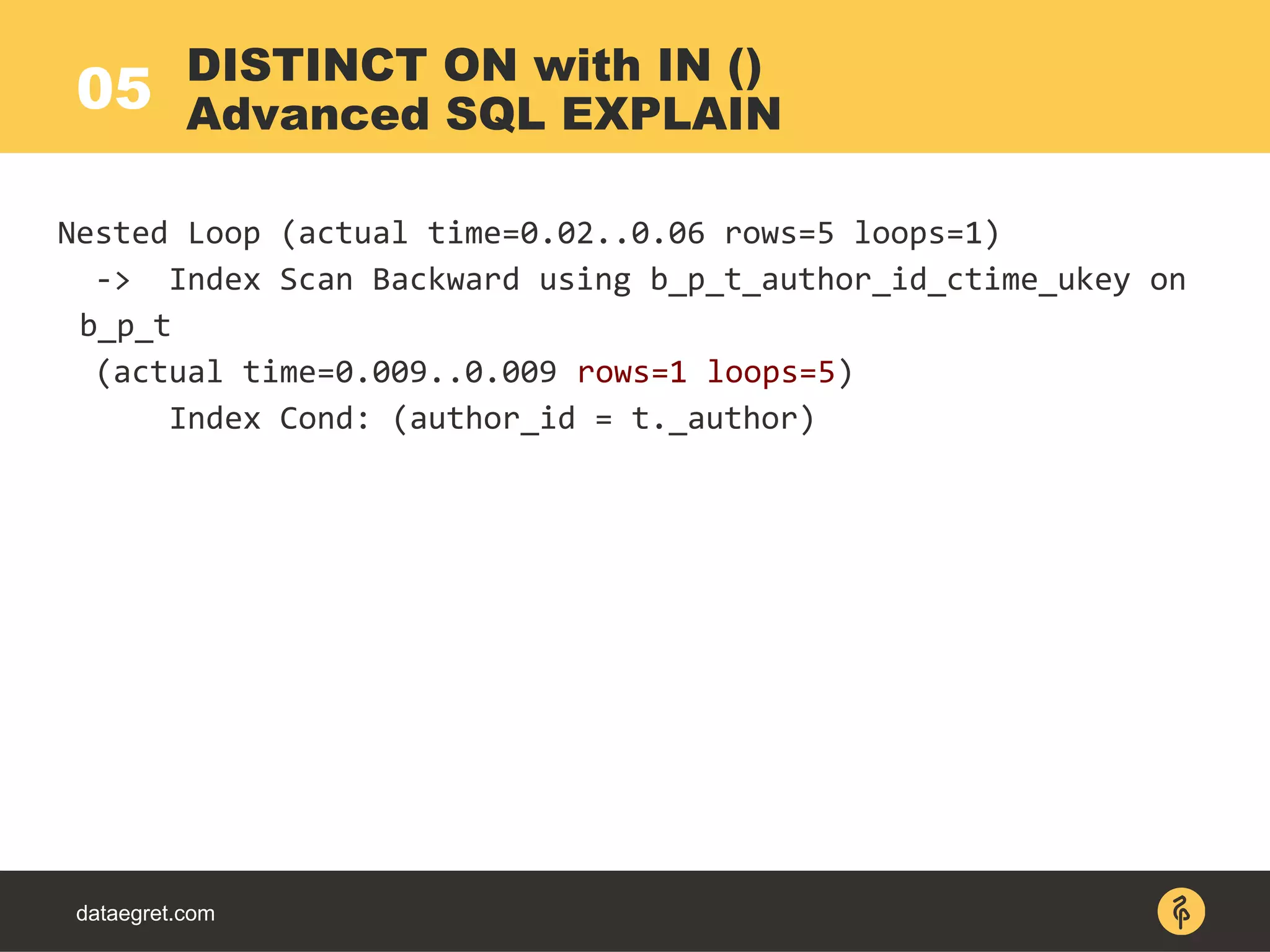
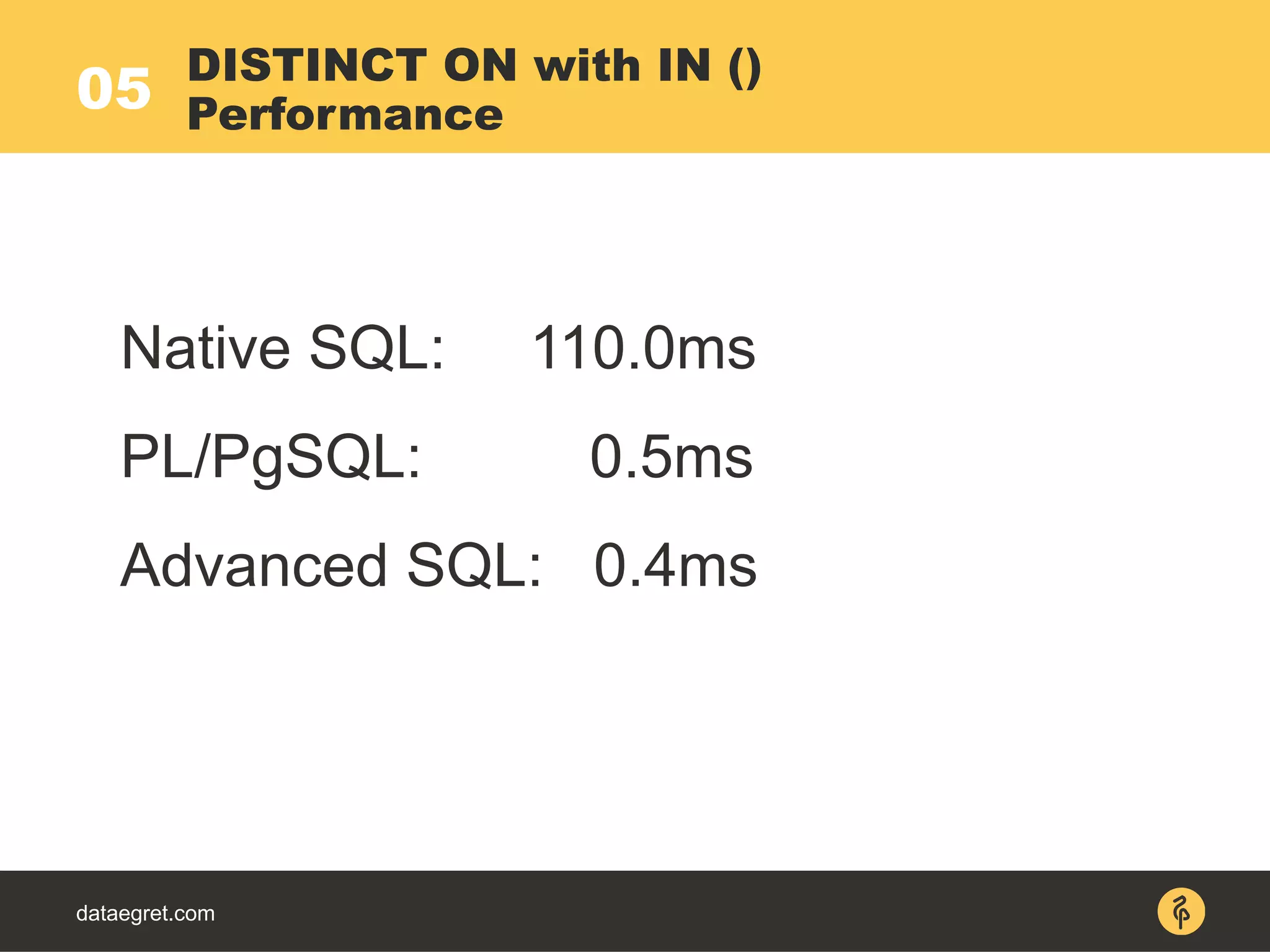


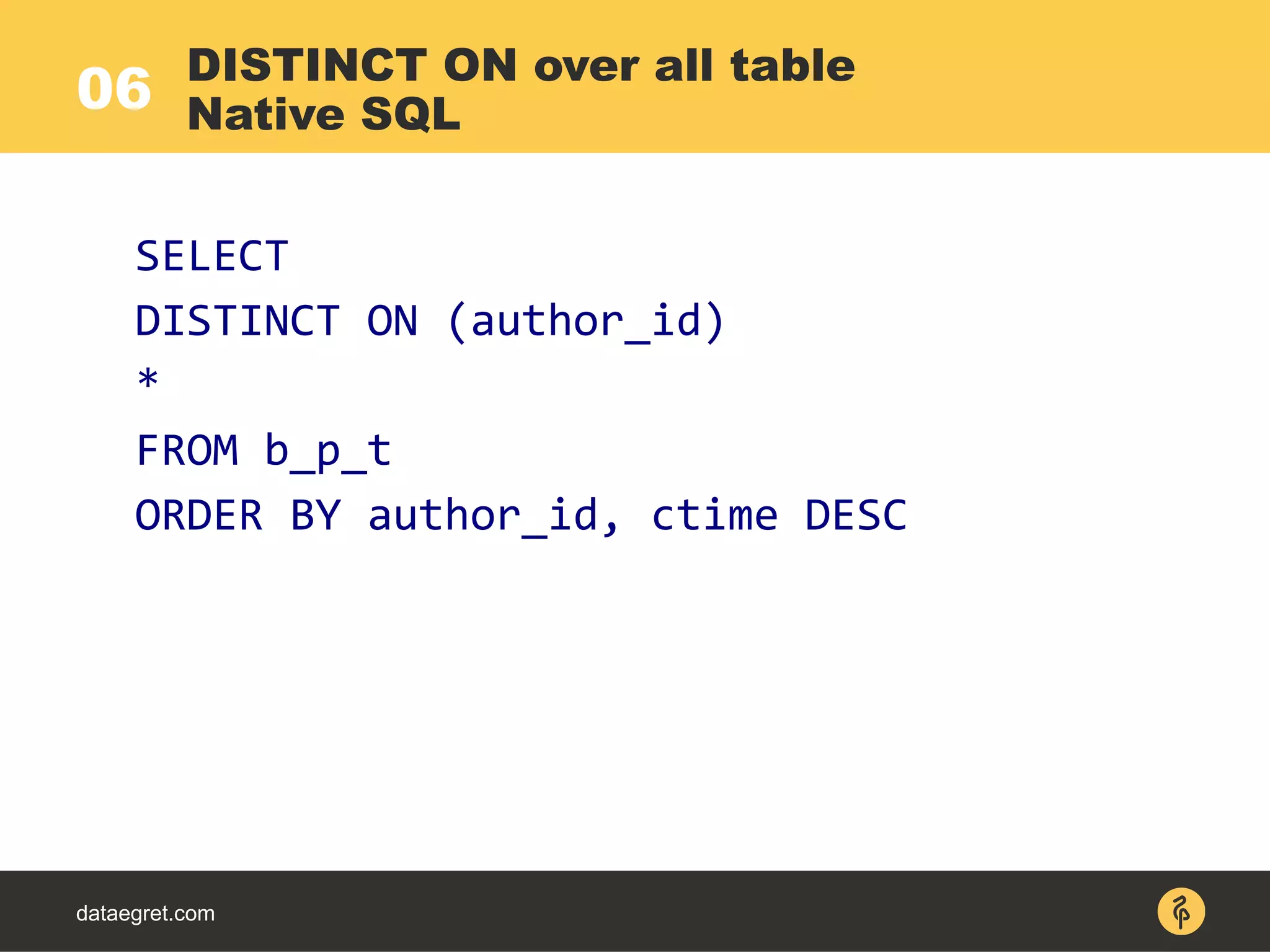
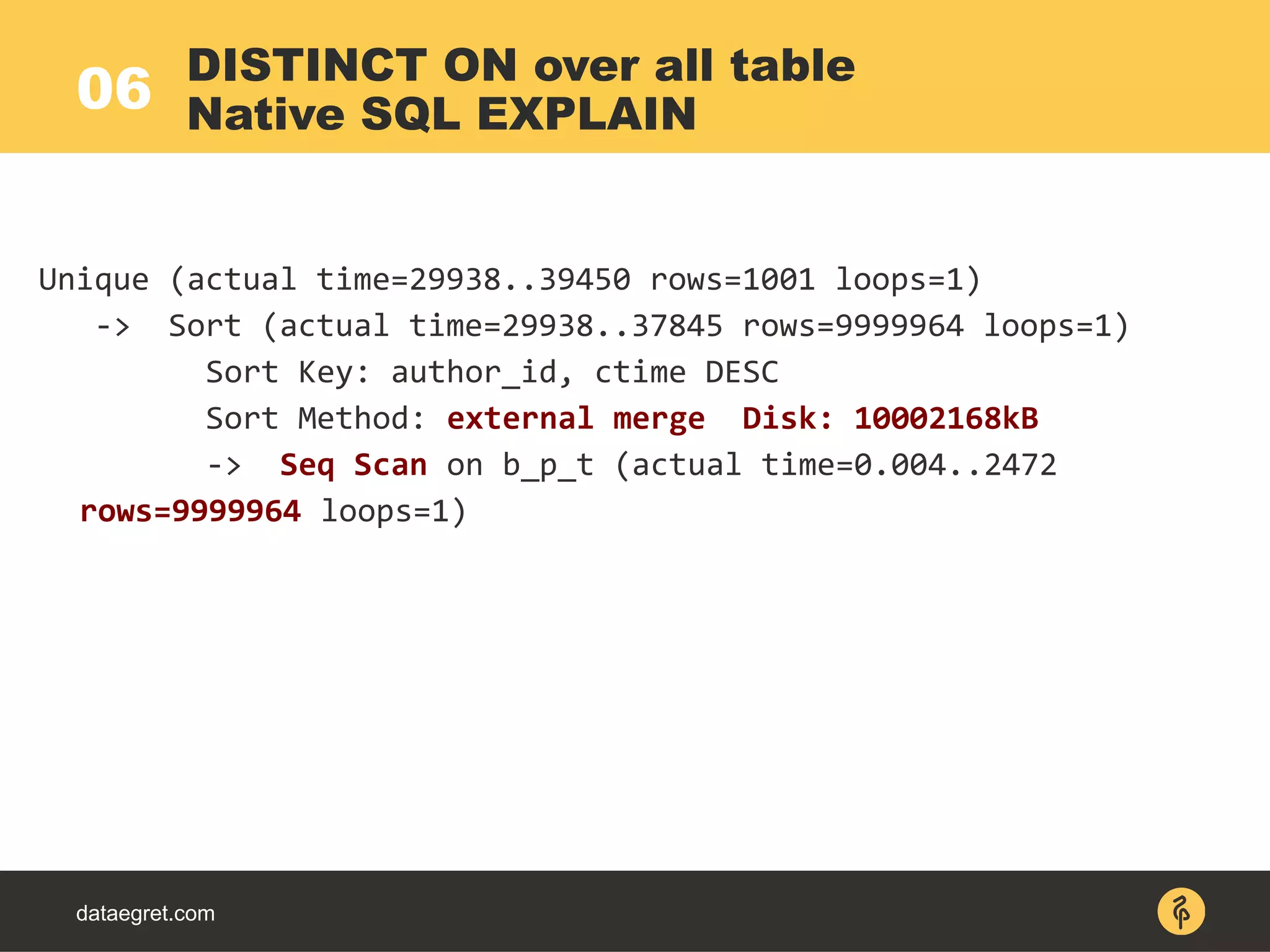

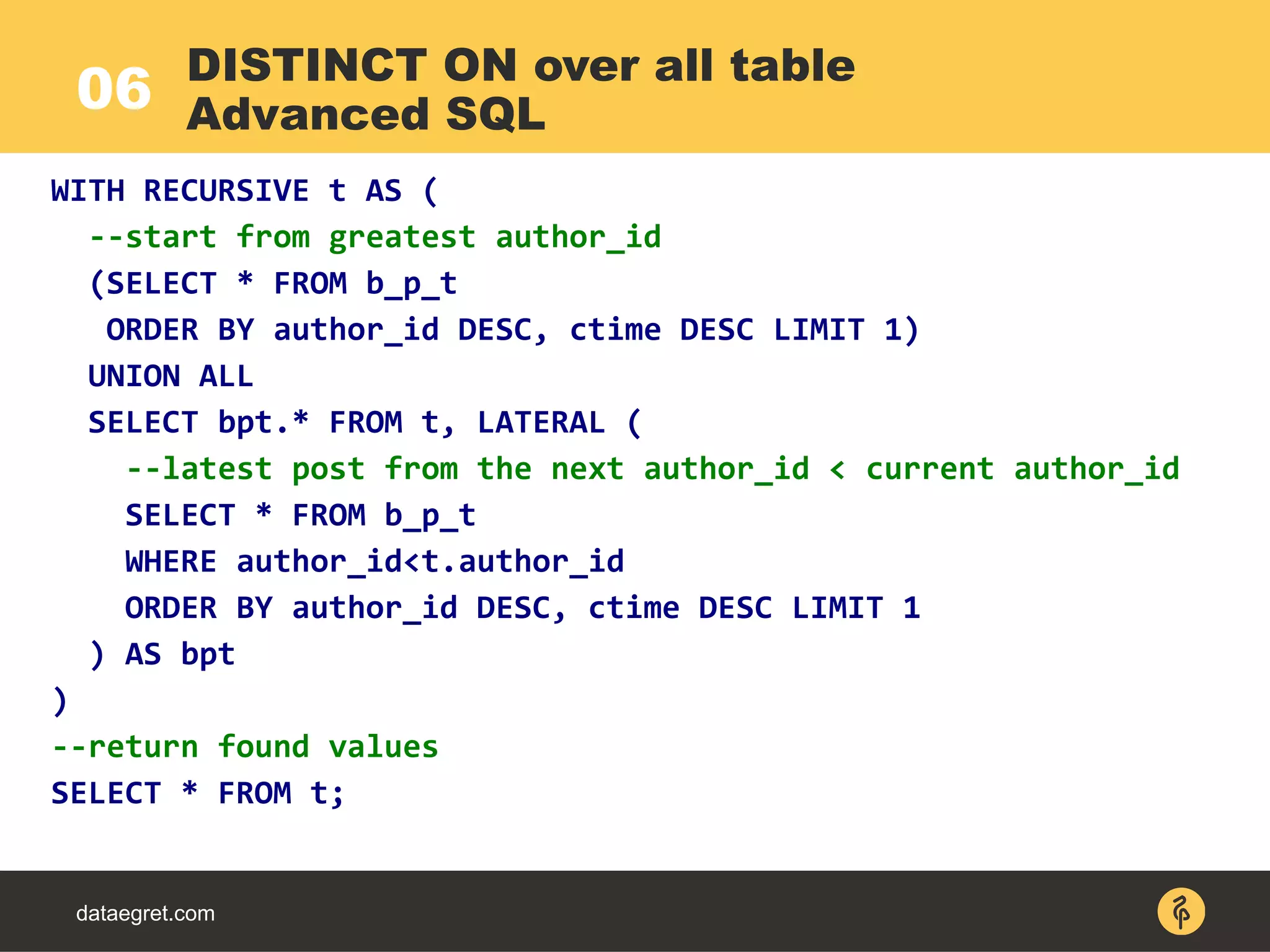
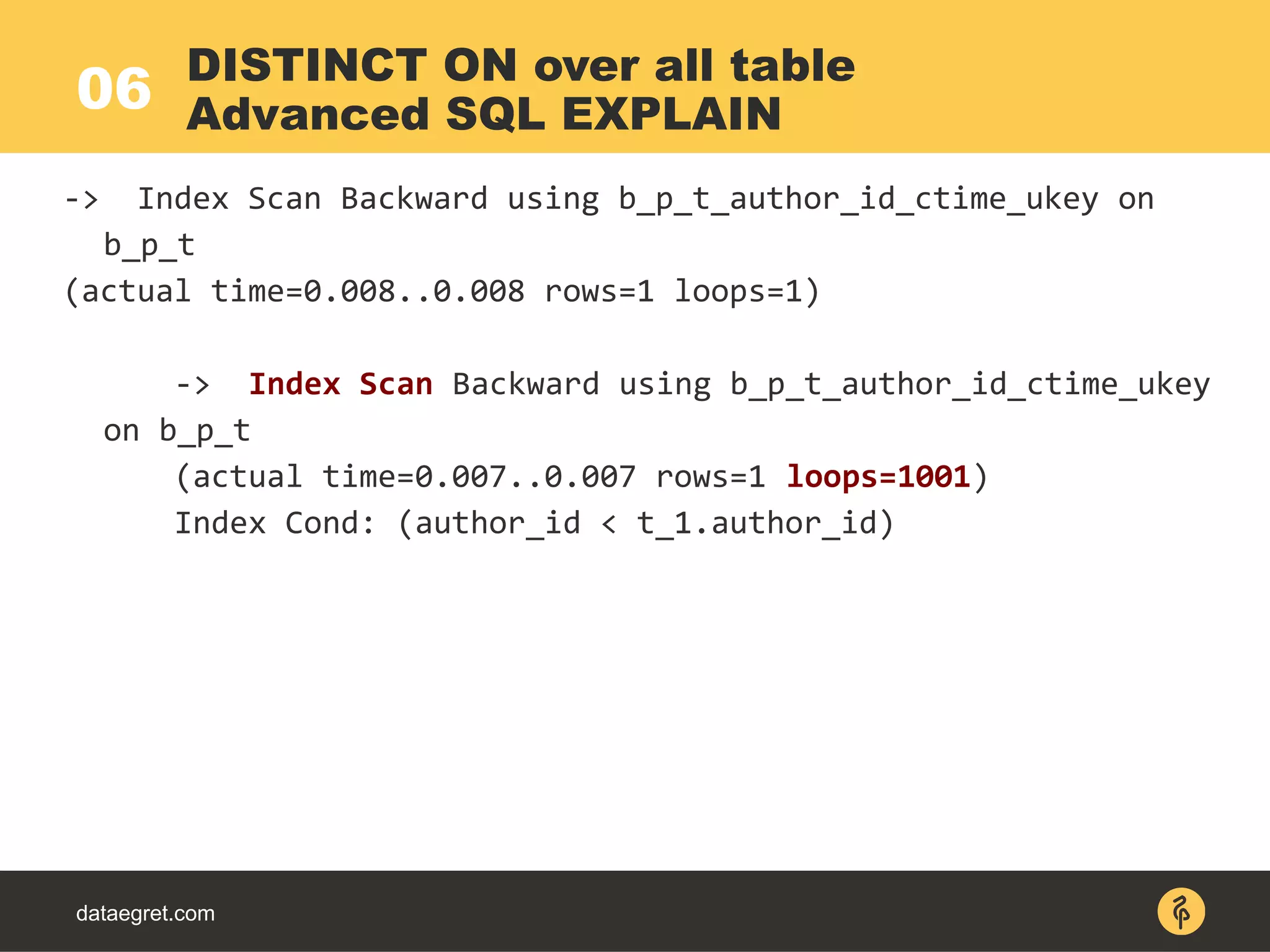

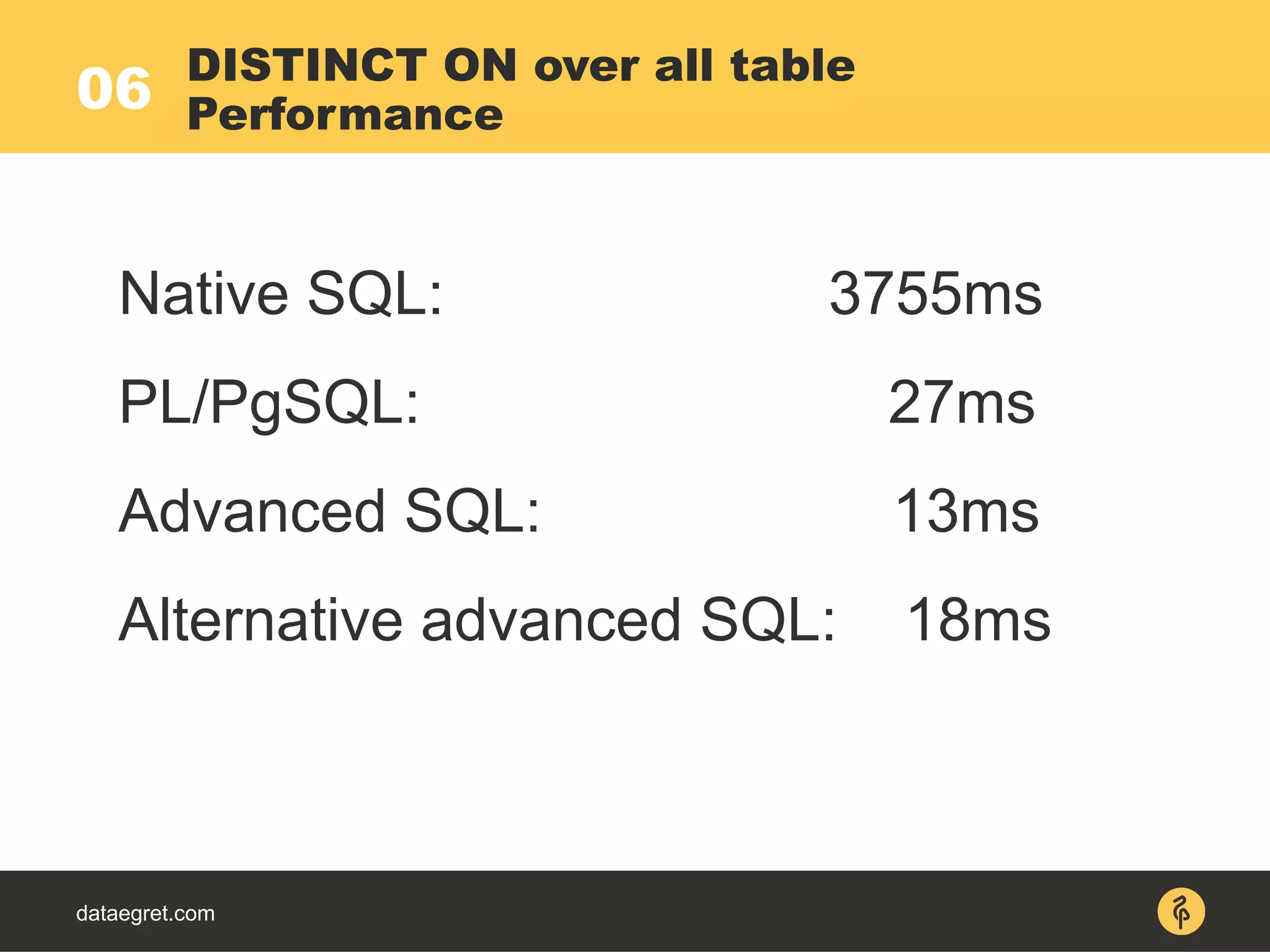
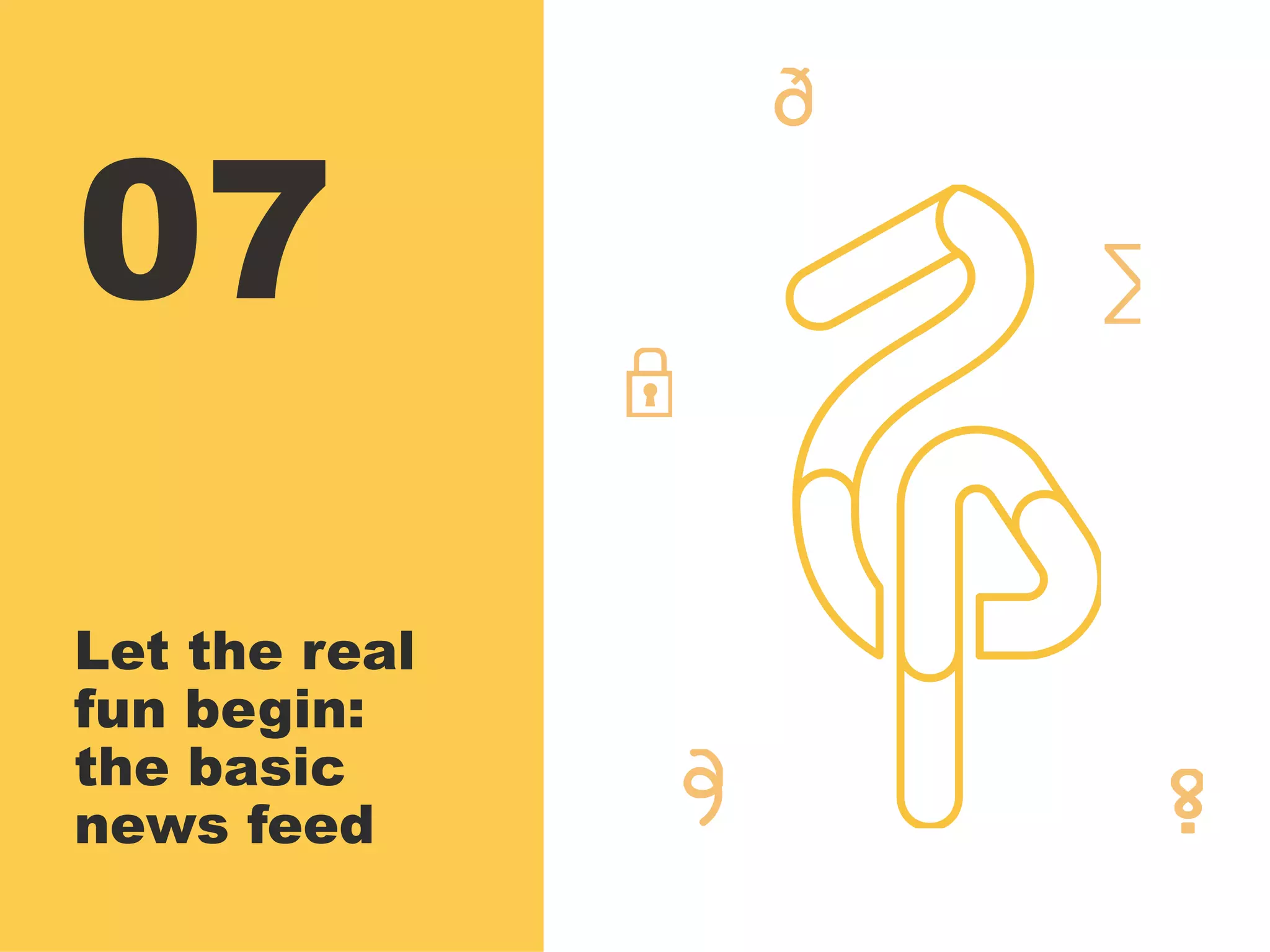
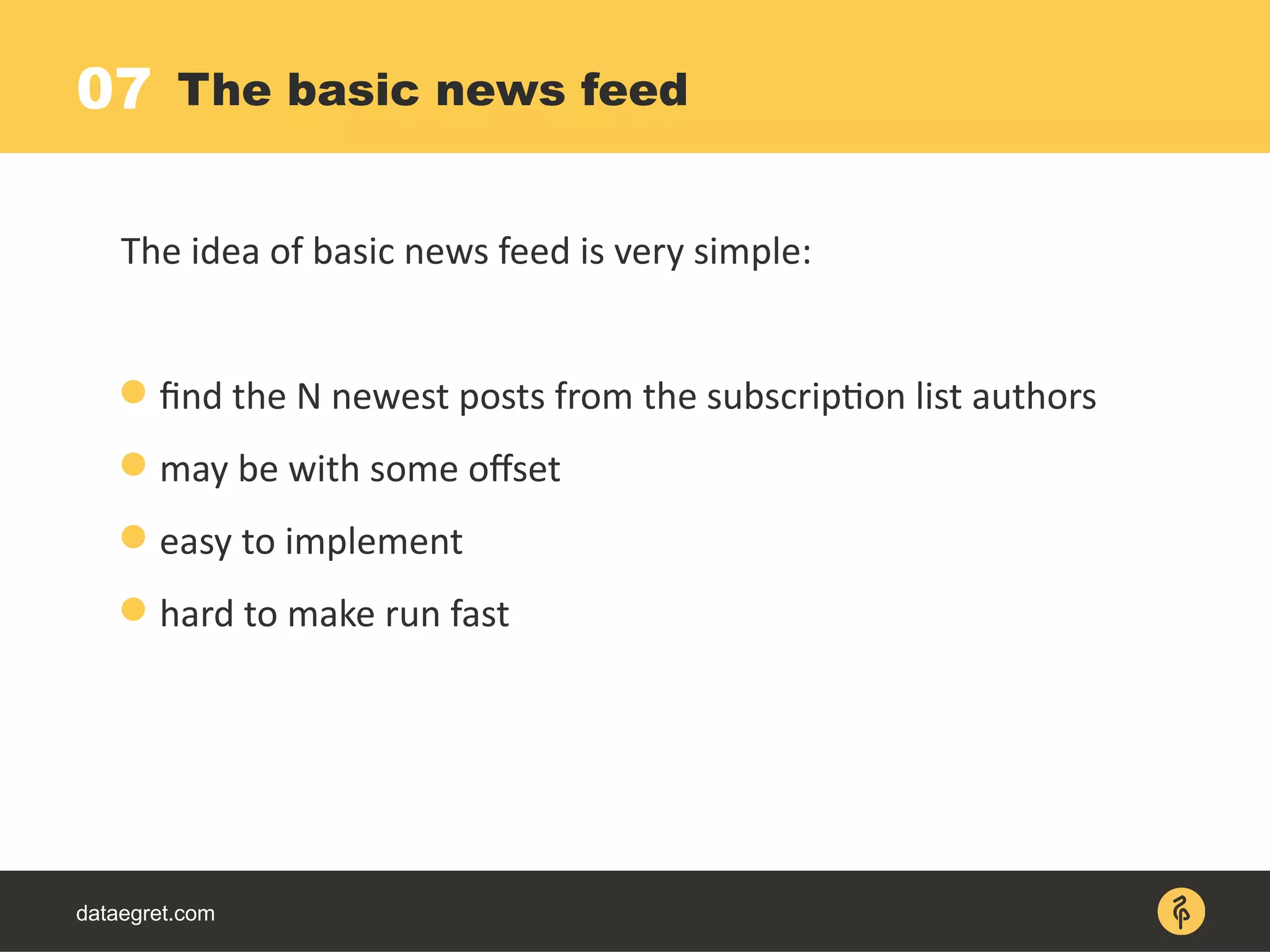
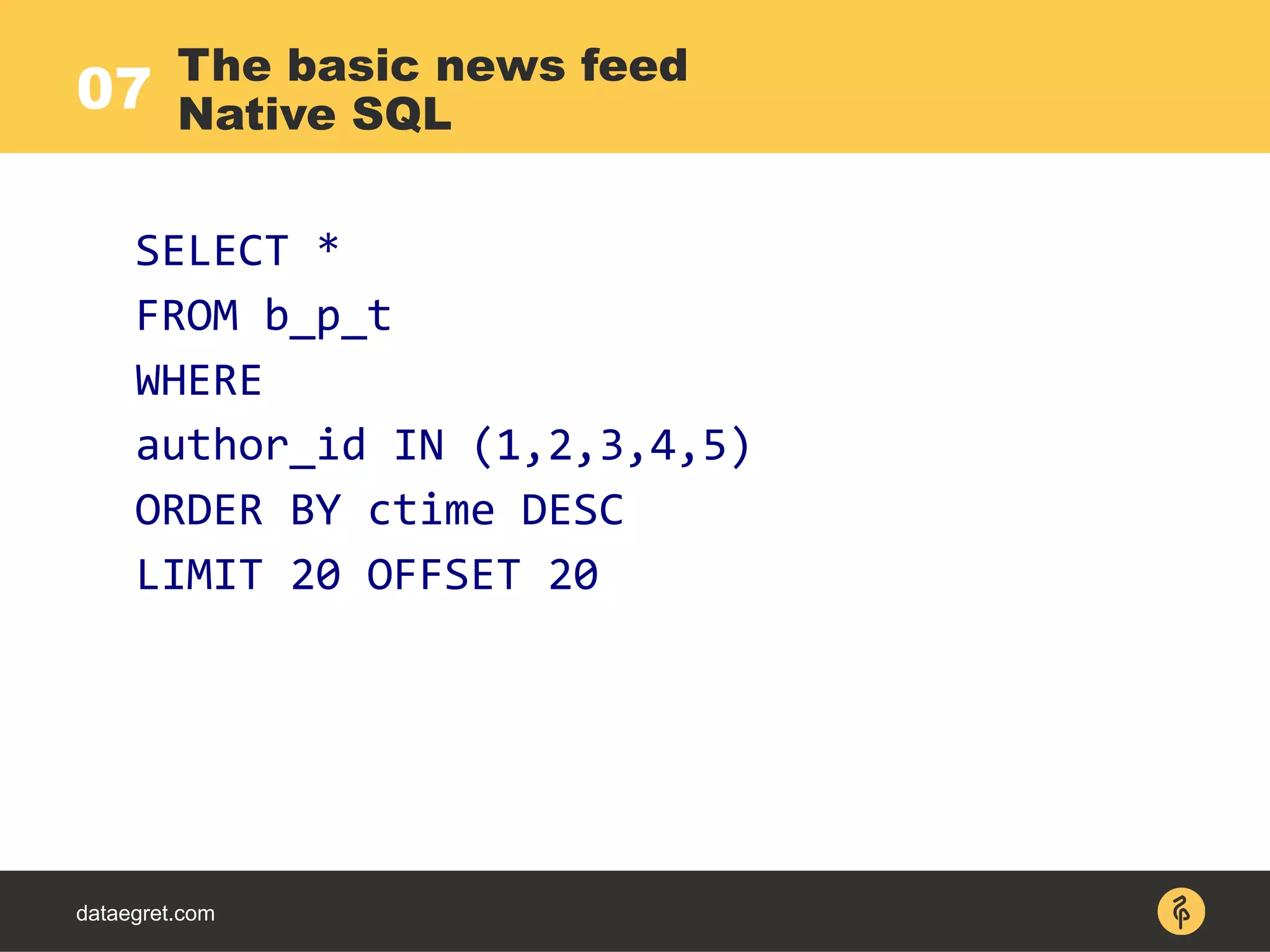
![07
dataegret.com
Limit (actual time=146..146 rows=20 loops=1)
-> Sort (actual time=146..146 rows=40 loops=1)
Sort Key: ctime DESC
Sort Method: top-N heapsort Memory: 84kB
-> Index Scan using bpt_a_id_ctime_ukey on b_p_t
(actual time=0.015..105 rows=50194 loops=1)
Index Cond: (author_id = ANY
('{1,2,3,4,5}'::integer[]))
The basic news feed
EXPLAIN](https://image.slidesharecdn.com/maximpgdayasia2017-170319053541/75/How-to-teach-an-elephant-to-rock-n-roll-59-2048.jpg)
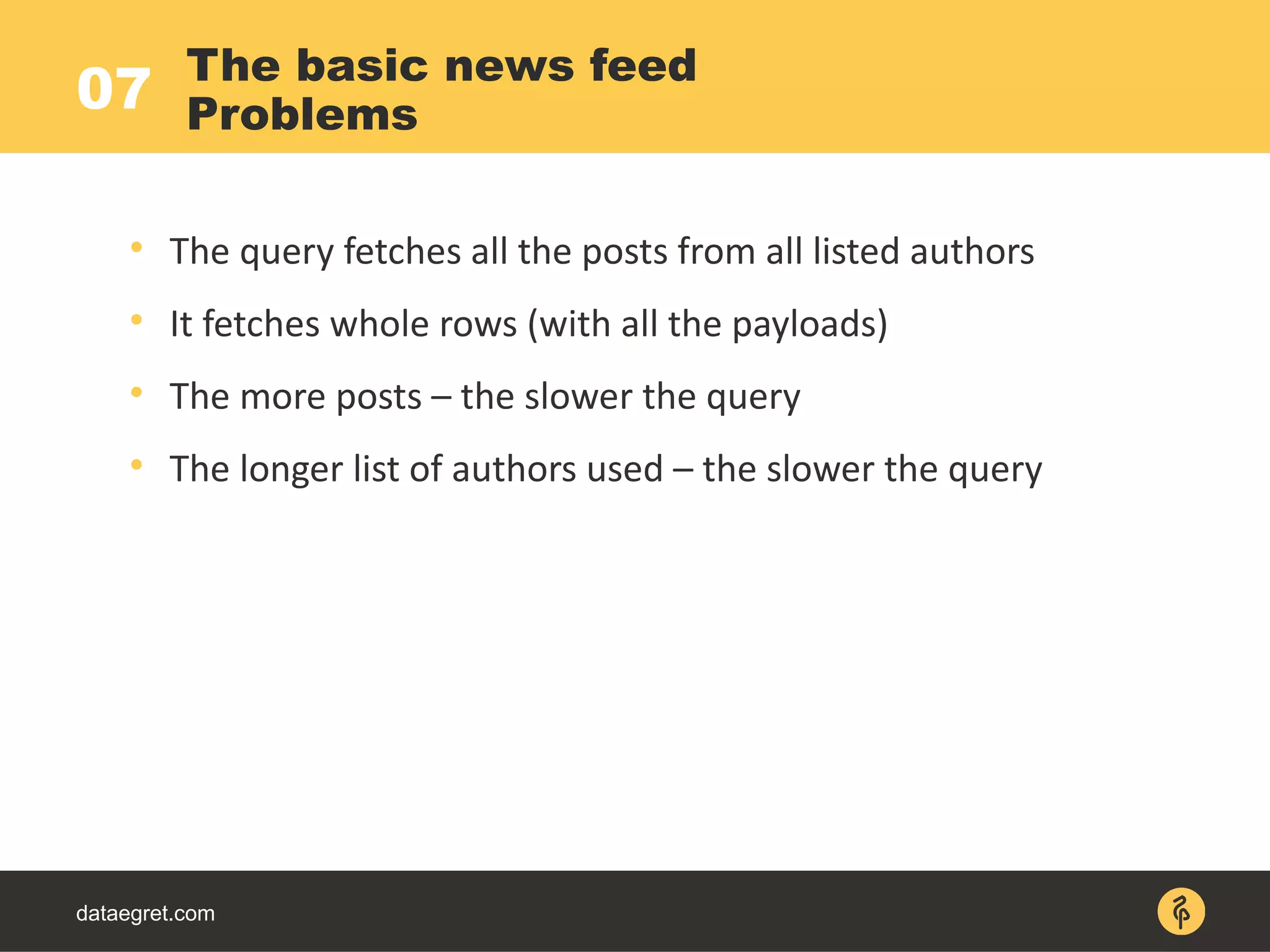

![07
dataegret.com
The basic news feed
Alternative idea Step 0
Lets start from array of the author_id (_a_ids):
'{20,10,30,100,16}'::int[]
pos author_id
1 20
2 10
3 30
4 100
5 16](https://image.slidesharecdn.com/maximpgdayasia2017-170319053541/75/How-to-teach-an-elephant-to-rock-n-roll-62-2048.jpg)
![07
dataegret.com
The basic news feed
Alternative idea Step 1
Now, using ideas from block 5 populate the ctime of
the latest posts for each author (_a_ctimes):
SELECT
array_agg((
SELECT ctime
FROM b_p_t WHERE author_id=_a_id
ORDER BY ctime DESC LIMIT 1
) ORDER BY _pos)
FROM
UNNEST('{20,10,30,100,16}'::int[])
WITH ORDINALITY AS u(_a_id, _pos)
pos ctime
1 01-02-2017
2 03-02-2017
3 10-02-2017
4 28-02-2017
5 21-02-2017](https://image.slidesharecdn.com/maximpgdayasia2017-170319053541/75/How-to-teach-an-elephant-to-rock-n-roll-63-2048.jpg)
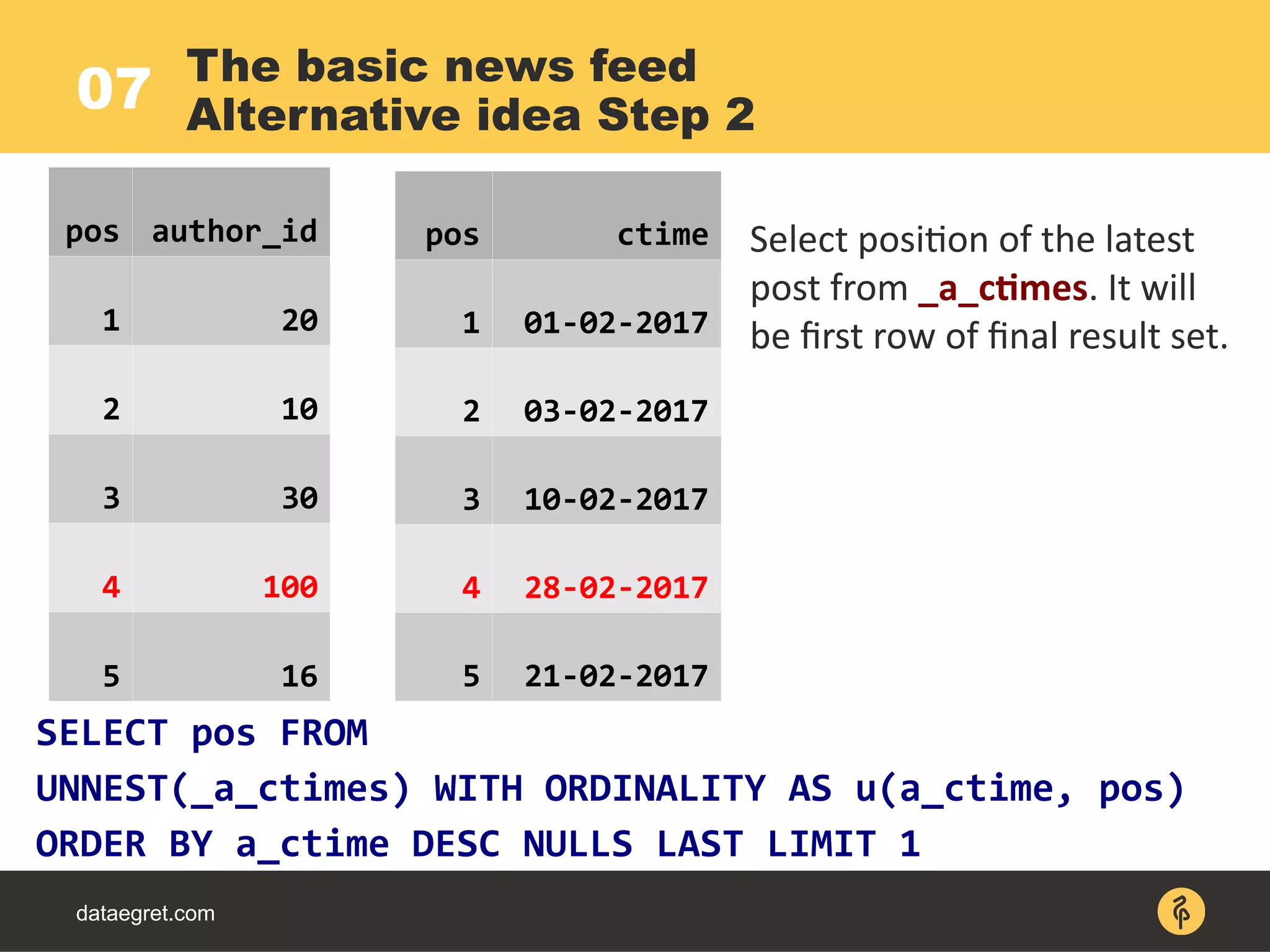
![07
dataegret.com
The basic news feed
Alternative idea Step 3
pos author_id
1 20
2 10
3 30
4 100
5 16
pos ctime
1 01-02-2017
2 03-02-2017
3 10-02-2017
4 28-02-2017
5 21-02-2017
Now, replace row 4 in _a_ctimes with ctime of the previous post from the
same author.
SELECT ctime AS _a_ctime FROM b_p_t WHERE author_id=_a_ids[pos]
AND ctime<_a_ctimes[pos] ORDER BY ctime DESC LIMIT 1
Found author_id ctime
1 4 28-02-2017](https://image.slidesharecdn.com/maximpgdayasia2017-170319053541/75/How-to-teach-an-elephant-to-rock-n-roll-65-2048.jpg)
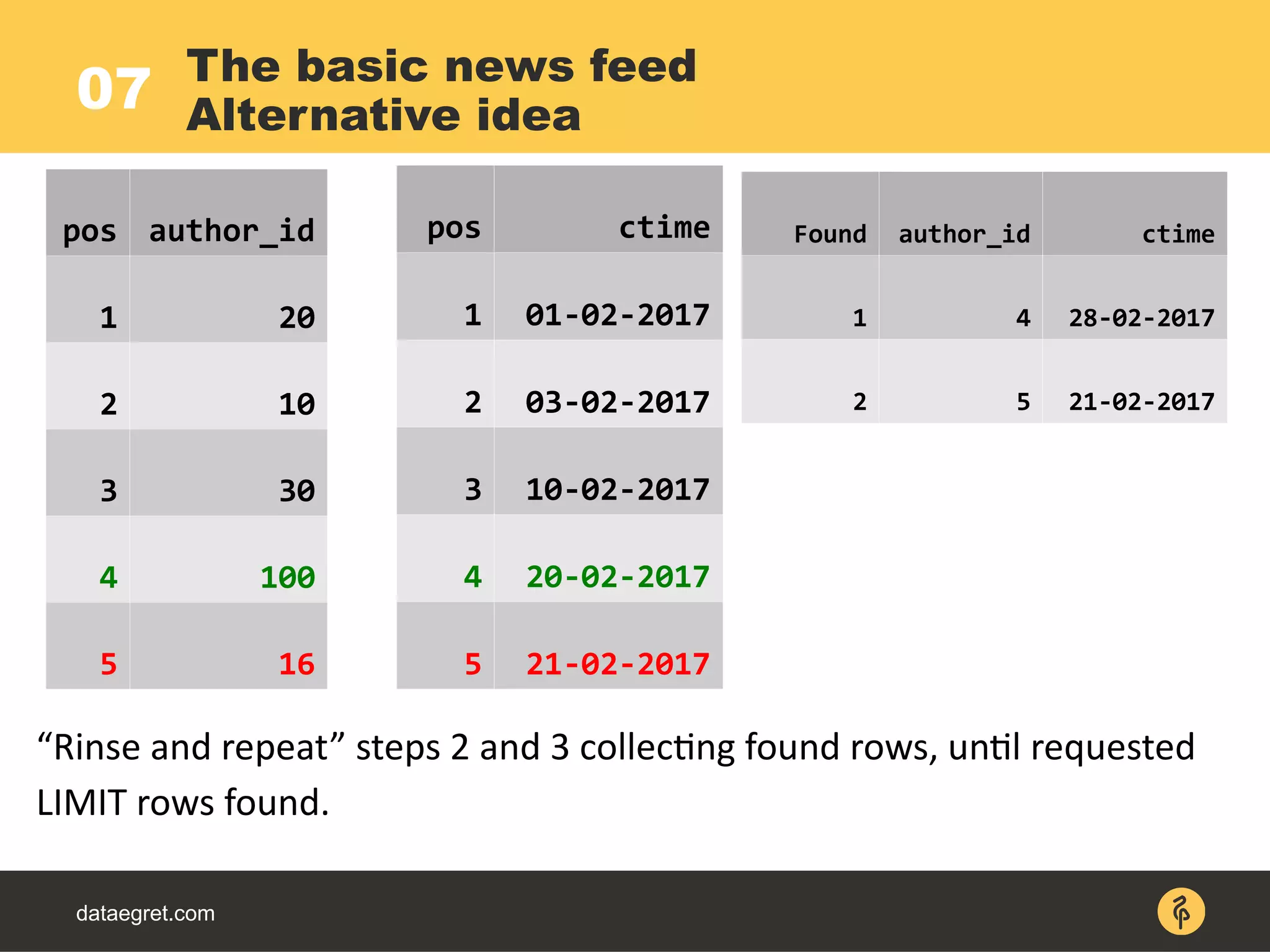
![dataegret.com
The basic news feed
PL/PgSQL07
CREATE OR REPLACE FUNCTION feed_test
(a_authors INT[], a_limit INT, a_offset INT) RETURNS SETOF b_p_t
LANGUAGE plpgsql
AS $function$
DECLARE _a_ids INT[] := a_authors;
DECLARE _a_ctimes TIMESTAMP[];
DECLARE _rows_found INT := 0;
DECLARE _pos INT;
DECLARE _a_ctime TIMESTAMP;
DECLARE _a_id INT;
BEGIN
-- loop over authors list
FOR _pos IN SELECT generate_subscripts(a_authors, 1) LOOP
--populate the latest post ctime for every author
SELECT ctime INTO _a_ctime FROM b_p_t WHERE
author_id=_a_ids[_pos] ORDER BY ctime DESC LIMIT 1;
_a_ctimes[_pos] := _a_ctime;
END LOOP;](https://image.slidesharecdn.com/maximpgdayasia2017-170319053541/75/How-to-teach-an-elephant-to-rock-n-roll-67-2048.jpg)
![dataegret.com
The basic news feed
PL/PgSQL (continue)07
WHILE _rows_found<a_limit+a_offset LOOP
--seek position of the latest post in ctime array
SELECT pos INTO _pos
FROM UNNEST(_a_ctimes) WITH ORDINALITY AS u(a_ctime, pos)
ORDER BY a_ctime DESC NULLS LAST LIMIT 1;
--get ctime of previous post of the same author
SELECT ctime INTO _a_ctime FROM b_p_t
WHERE author_id=_a_ids[_pos] AND ctime<_a_ctimes[_pos]
ORDER BY ctime DESC LIMIT 1;](https://image.slidesharecdn.com/maximpgdayasia2017-170319053541/75/How-to-teach-an-elephant-to-rock-n-roll-68-2048.jpg)
![dataegret.com
The basic news feed
PL/PgSQL (continue)07
--offset rows done, start return results
IF _rows_found>=a_offset THEN
RETURN QUERY SELECT * FROM b_p_t
WHERE author_id=_a_ids[_pos]
AND ctime=_a_ctimes[_pos];
END IF;
--increase found rows count
_rows_found := _rows_found+1;
--replace ctime for author with previous message ctime
_a_ctimes[_pos] := _a_ctime;
END LOOP;
END;
$function$;](https://image.slidesharecdn.com/maximpgdayasia2017-170319053541/75/How-to-teach-an-elephant-to-rock-n-roll-69-2048.jpg)
![07
dataegret.com
WITH RECURSIVE
r AS (
SELECT
--empty result
NULL::b_p_t AS _return,
--zero rows found yet
0::integer AS _rows_found,
--populate author ARRAY
'{1,2,3,4,5}'::int[] AS _a_ids,
--populate author ARRAY of latest blog posts
(SELECT
array_agg((
SELECT ctime FROM b_p_t WHERE author_id=_a_id ORDER BY ctime DESC LIMIT 1
) ORDER BY _pos)
FROM UNNEST('{1,2,3,4,5}'::int[]) WITH ORDINALITY AS u(_a_id, _pos)
) AS _a_ctimes
UNION ALL
SELECT
--return found row to the result set if we already done OFFSET or more entries
CASE WHEN _rows_found>=100 THEN (
SELECT b_p_t FROM b_p_t WHERE author_id=_a_ids[_pos] AND ctime=_a_ctimes[_pos]
) ELSE NULL END,
--increase found row count
_rows_found+1,
--pass through the same a_ids array
_a_ids,
--replace current ctime for author with previous message ctime for the same author
_a_ctimes[:_pos-1]||_a_ctime||_a_ctimes[_pos+1:]
FROM r,
LATERAL (
SELECT _pos FROM UNNEST(_a_ctimes) WITH ORDINALITY AS u(_a_ctime, _pos)
ORDER BY _a_ctime DESC NULLS LAST LIMIT 1
) AS t1,
LATERAL (
SELECT ctime AS _a_ctime FROM b_p_t WHERE author_id=_a_ids[_pos] AND ctime<_a_ctimes[_pos]
ORDER BY ctime DESC LIMIT 1
) AS t2
--found the required amount of rows (offset+limit done)
WHERE _rows_found<105
)
SELECT (_return).* FROM r WHERE _return IS NOT NULL ORDER BY _rows_found;
The basic news feed
Advanced SQL](https://image.slidesharecdn.com/maximpgdayasia2017-170319053541/75/How-to-teach-an-elephant-to-rock-n-roll-70-2048.jpg)
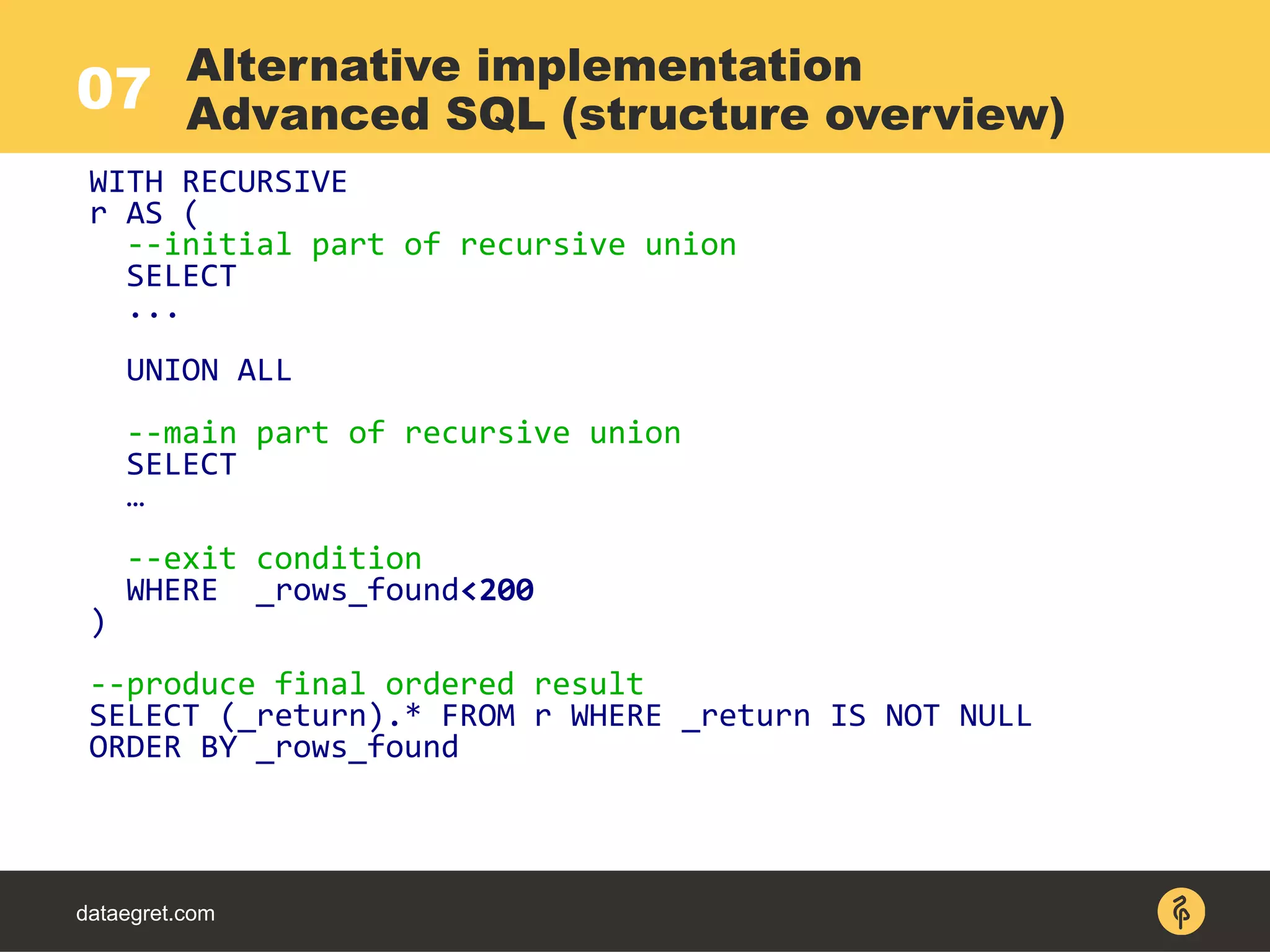
![07
dataegret.com
--empty result
NULL::b_p_t AS _return,
--zero rows found so far
0::integer AS _rows_found,
--author ARRAY
'{1,2,3,4,5}'::int[] AS _a_ids,
--populate author ARRAY of latest blog posts (see part 5)
(SELECT
array_agg((
SELECT ctime FROM b_p_t WHERE author_id=_a_id ORDER BY
ctime DESC LIMIT 1
) ORDER BY _pos)
FROM UNNEST('{1,2,3,4,5}'::int[]) WITH ORDINALITY AS
u(_a_id, _pos)
) AS _a_ctimes
Alternative implementation
Advanced SQL (initial part)](https://image.slidesharecdn.com/maximpgdayasia2017-170319053541/75/How-to-teach-an-elephant-to-rock-n-roll-72-2048.jpg)
![07
dataegret.com
--return found row to the result set if we already done OFFSET or more entries
CASE WHEN _rows_found>=100 THEN (
SELECT b_p_t FROM b_p_t WHERE author_id=_a_ids[_pos] AND ctime=_a_ctimes[_pos]
) ELSE NULL END,
--increase found row count
_rows_found+1,
--pass through the same a_ids array
_a_ids,
--replace current ctime for author with previous message ctime
_a_ctimes[:_pos-1]||_a_ctime||_a_ctimes[_pos+1:]
FROM r,
LATERAL (
SELECT _pos FROM UNNEST(_a_ctimes) WITH ORDINALITY AS u(_a_ctime, _pos)
ORDER BY _a_ctime DESC NULLS LAST LIMIT 1
) AS t1,
LATERAL (
SELECT ctime AS _a_ctime FROM b_p_t
WHERE author_id=_a_ids[_pos] AND ctime<_a_ctimes[_pos]
ORDER BY ctime DESC LIMIT 1
) AS t2
Alternative implementation
Advanced SQL (main part)](https://image.slidesharecdn.com/maximpgdayasia2017-170319053541/75/How-to-teach-an-elephant-to-rock-n-roll-73-2048.jpg)
